December 12th, 2011
“I wish to explore what remains for most – and has been for me – a terra incognita, a forbidden place, a heart of darkness that civilised people have long attempted to repress – that is, the wilderness within the human soul and without, in that living profusion that envelops all creation.”
.
~ Max Oelschlaeger, The Idea of Wilderness: From Prehistory to the Age of Ecology (1993)
.
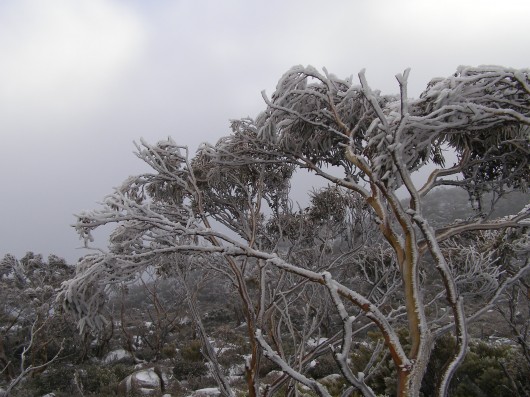 Pinnacle of Mount Wellington, Tasmania
(Photo by Editor 20111001, free in public domain, click photo to enlarge) Pinnacle of Mount Wellington, Tasmania
(Photo by Editor 20111001, free in public domain, click photo to enlarge)
.
In 2007, former United States Vice President Al Gore‘s campaign to educate citizens about global warming was portrayed in an award winning documentary film ‘An Inconvenient Truth‘.
The subject matter, global warming, has indeed become an inconvenient truth because the global scale of the problem is such that the powers that be have so far been finding it difficult to comprehend. They have been told that it demands a response so systemic as to be transformational, which is highly inconvenient for them to say the least. The transformational response is mostly inconvenient to the powerful vested interests in polluting industries that are key contributors to global warming – particularly oil, gas, coal, heavy manufacturing, transport and weapons industries.
.
‘Deluded Convenience’
.
On the flip side of this inconvenience of the truth, powerful vested interests understandably, are hell bent on maintaining their convenient business as usual practices, choosing to ignore, reject and deny the truth. It is their short term interests to do so, because change is expensive and threatens to diminish their power, influence and wealth. But in the long term, by perpetuating practices that are shown to be damaging to the Earth’s climate, the imperative of maintaining a convenient business as usual approach is a deluded one, as everyone will be adversely affected by global warming. They are only deluding themselves. Such harmful business-as-usual practice is a ‘deluded convenience‘.
Harmful business-as-usual practices that are contributing to global warming were once branded aspiringly in the 18th, 19th and 20th Centuries as ‘industrial progress‘. The widespread Western culture from Western Europe and the United States has for over three hundred years idolised the ‘civilised’ advances of the Industrial Revolution, capitalism and economics. Western economies now have many conveniences of lifestyle, but attaining them has caused considerable cost to societies and ecology. Globalisation has destroyed family-based enterprises, local markets and village communities and caused wars and immense suffering. Industrialisation has destroyed many forests, rivers, valleys, coastlines and species. These have been the cost of convenience, the cost of civilisation; and we are now paying the price.
.
“It is fairly widely accepted today that environmental destruction ultimately becomes self-destructive as a sick and impoverished global environment in turn sickens and impoverishes the human members of that ecosystem.
..Why, despite warning signs from a stressed global ecosystem, mounting scientific evidence, and public education campaigns, does degradation of the environment continue to persist and mount?”
.
~ Catherine M. Roach, 2003, ‘Mother Nature: Popular Culture and Environmental Ethics.
.
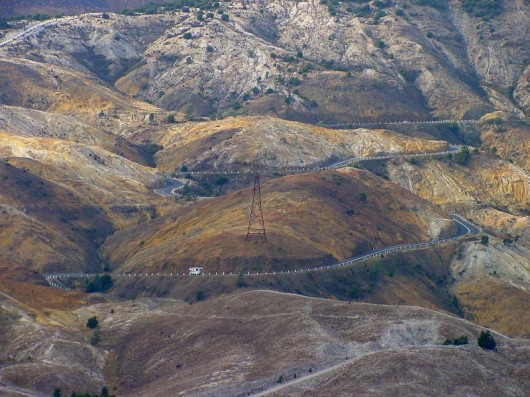 Absolute environmental destruction above Queenstown, Tasmania Absolute environmental destruction above Queenstown, Tasmania
.
Bushphobia – a form of deluded convenience
.
Bushphobia is a composite term emanating from Australia, which combines two words ‘bush’ meaning the native forest and scrub environment of Australia’s unique animals and plants, with the non-clinical use of the term ‘phobia’. Phobia (from Greek φόβος, phóbos: fear, phobia) is an anxiety association, a negative attitudes towards, a dislike, disapproval, prejudice, discrimination, or hostility of, aversion to, or discrimination against something. Bushphobia is borne out of learnt acculturation adopting two distinct attitudes:
- A deep fear of the bush due to its propensity to burn and cause horrific wildfires
- A dislike of Australian native vegetation due to its wild untamed appearance which is so different to exotic trees and landscapes that have a more symmetrical and accessible character
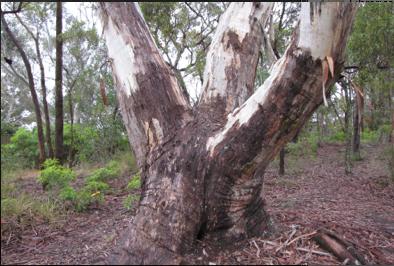 An Australian native tree discriminated against by a pro-development Court ruling…because it may be dangerous
^http://www.savethetree.org/
An Australian native tree discriminated against by a pro-development Court ruling…because it may be dangerous
^http://www.savethetree.org/
In this case a discrimination against the bush, where the word ‘bush’ is an Australian term for native forest and scrubland. Bushphobia was first used with its modern meaning in 2008 in the Blue Mountains in eastern Australia which represents an intolerance and prejudice against the natural Australian bush vegetation mainly because of its susceptibility to burning in the case of bushfires and the consequential fire threat to life and private property.
The combined meaning is to have a persistent irrational fear specific fear or loathing of the natural (bush) environment. There are three classes of phobias: agoraphobia, social phobia, and specific phobia (Wood 521). Bushphobia is a specific phobia associated with a fear of natural environment.
Bushphobia is a socially learnt fear and loathing toward the bush common amongst rural volunteer bushfire fighting organisations which is instilled in new recruits as part of the training tans assimilation process. Bushphobia has thus become a form of learned cultural prejudice amongst the rural fire fighting fraternity throughout Australia. This attitude becomes deep seated and a motive to regard native forests, not as valued natural assets and habitat for native flora and fauna, but only as a combustible fuel that is prone to burn and thus a menace and ‘hazard’. The standard myth conveyed about the bush that inculcates bushphobia is that if the bush is not destroyed and allowed to grow naturally then the bush will develop into an uncontrollable fuel that in the event of a bushfire will cause an horrific fire storm and Armageddon. The issue of inadequate bushfire fighting capabilities is conveniently ignored.
Those who only see the bush through a bushphobic mindset desire to burn it, bulldoze it and destroy it at any opportunity when weather permits such action to be done safely. Deliberate burning of the bush has become a ‘prescribed burning’ policy of Australian governments at both state and federal level attracting massive resources. In New South Wales prescribed burning is labelled ‘hazard reduction’. History however has shown repeatedly that many prescribed burning activities frequently escape control lines an end up destroying vast areas of bush.
.
.
NIMBYism – a celebration of ‘think globally, act locally’
.
The maxim ‘Think globally, act locally‘ has long passed into the vernacular, urging grassroots activism where thinking about the health of the entire planet is translated into taking action at a local level in one’s own community. The phrase has been originally attributed to Scottish town planner and social activist Sir Patrick Geddes FRSE [1854-1932].
 Sir Patrick Geddes (c.1886) Sir Patrick Geddes (c.1886)
.
At a time in the early 20th Century when industrialisation was dramatically altering the conditions of social life, Geddes recognised the role of architectural amenity on urban life, particularly promoting the happiness, health and comfort of all residents, rather than focusing on roads and parks available only to the rich. He applied this in his design of Edinburgh, Tel Aviv and Bombay. Geddes was an advocate of nature conservation and strongly opposed to industrial pollution. Some historians have claimed he was a forerunner of modern Green politics. At a time of rapid urban growth, Geddes coined the term ‘conurbation’ observing how population growth was pushing large towns to merge into one continuous urban and industrially developed area. In Geddes’ 1915 book “Cities in Evolution” his advocacy of maintaining local character in urban planning is clearly evident:
‘Local character’ is thus no mere accidental old-world quaintness, as its mimics think and say. It is attained only in course of adequate grasp and treatment of the whole environment, and in active sympathy with the essential and characteristic life of the place concerned.’
.
Prominent American environmentalist and mountaineer David Brower [1912 – 2000] and founder of Friends of the Earth (FOE) in 1969 is believed to have been the first to applied the phrase ‘think globally, act locally‘ in an environmental context as the slogan for FOE. Application of ‘think globally, act locally‘ maxim in this environmental context has manifest itself most prevalently when grassroots activism erupts as a result of inappropriate land use development threats. Local residents opposing inappropriate development are following the thinking of Geddes by recognising the important value of local amenity to the health and happiness of local residents. Developers are quick to deride the rights of local residents to defend their neighbourhood amenity, labelling them as NIMBY‘s – an acronym for the phrase “Not In My Back Yard“, first coined in 1980 by British writer Emilie Travel Livezey in an article ‘Hazardous Waste‘.
Nimbyism is used typically by proponents of a development to pejoratively describe opposition by neighbouring residents. Nimbyism, however is simply acting locally to protect the values of one’s neighbourhood. Standing by and watching an inappropriate development proceed is an option, but why stand by? Residents who plan to live in a locality for some time and perhaps for the rest of their lives, have a democratic right and a say in what happens to their locality and this includes a say its preserving or changing the locality’s amenity and character. It is about holding strong principles of community governance and valuing the rights of locals to participate in decisions that directly affect them. Local residents are the stakeholders who will have to live permanently with a development and so are most deserving in having a louder voice in development decisions to balance corporate developers and their investors.
Amusing variants of NIMBY are:
- ‘NIMFYE’ = Not In My Front Yard Either
- ‘NIMTOO’ = Not In My Term Of Office [a favourite of politicians]
- ‘NITL’ = Not In This Lifetime
- ‘NOPE’ = Not On Planet Earth
- ‘NOTE’ = Not Over There Either
- ‘GOOMBY’ = Get Out Of My Backyard [Common in new suburbs that encroach on industrial sites or airports]
- ‘NIABY’ = Not in Anyone’s Backyard
- ‘NUMBY’ = Not Under My Backyard (applicable to mining companies)
.
And this Editor’s favourite:
- ‘BANANA’ = Build Absolutely Nothing Anywhere Near Anything
.
.
‘A recent report has found that nearly 80% of U.S. residents oppose any new development in their community. It’s the highest level of opposition recorded in the report’s six-year history, and the first time since 2008 that the amount of opposition has increased.’
.
[Source: ‘As America Ages, NIMBYism Could Increase, by Nate Berg, The Atlantic Cities, 20111017, ^http://www.theatlanticcities.com/politics/2011/10/as-america-ages-nimbyism-could-increase/306/]
Given that Nimyism is a developer term used derogatorily against residents who dare to question and challenge land use development , the counter-language on the side of residents is ‘property rights‘ and ‘planning democracy‘. Many residents out of frustration with the local planning process decide to form an action group. One organisation well experienced in this quest is Sydney-based Save Our Suburbs.
.
Save Our Suburbs
.
‘Save Our Suburbs (NSW) Inc is a non-profit & non-aligned group of residents, originally formed to fight against forced rezoning and over-development of Sydney’s suburbs. It has grown to include communities who are fighting for better planning and regulation on a range of development issues, including major infrastructure projects such as road tunnels. Sydney’s beleaguered residents have been fighting an endless string of localised battles against increased density developments (‘urban consolidation‘) and badly planned developments such as unfiltered tunnel exhaust stacks. We have been fighting local councils about local rezoning and local developments, and state government departments about the lack of regulation and planning. Residents are usually the losers in these local battles. If we want to effectively protect the environment and heritage of our suburbs, we need to take the fight beyond our local areas into the State Government arena. This can only be achieved by organised and united residents. Save Our Suburbs (NSW) Inc has been formed for this very purpose.
.
Fundamental Objectives:
- Return Planning democracy to New South Wales, by allowing true consultation, and giving planning power back to local councils: The people should decide, not a Planning Dictator!
- End big developer donations to political parties: We want planning decisions based on merit, not on money!
- Save our property rights: Provide just compensation for loss of land, income or amenity, and for change of land use.
- End forced urban consolidation- allow sensible land release, with infrastructure funded by the government: Dump the failed planning policies, designed to favour big developers rather than the community.
Read More: ^http://www.sos.org.au/
.
.
Bushphobia – a ‘case’ of deluded convenience
.
‘Our urban footprint is encroaching further and further into bushland. The amount of land used as space for community living is decreasing as urban settlements have sprawled. This is affecting the opportunities we now have to meet and interact as communities. The consequences of urban sprawl include a decline in the supply of affordable housing, increased bushfire risk for individuals and property and increasing impacts on the environment.’
Historically, much of the development in the Blue Mountains has encroached well into bushland with little regard for environmental impact and often without supporting infrastructure, such as sewerage and transport systems. This dispersed, sprawling development pattern along ridgelines has been added to by post war residential development, creating many of the ‘suburbs’, particularly in the lower Blue Mountains. As all available sites for new development dry up it is likely that existing urban areas will come under increasing pressure for redevelopment.’
[Source: Blue Mountains Council, ^http://www.sustainablebluemountains.net.au/imagesDB/resources/Paper14bOurFuture.pdf, p.4]
 An example of current housing encroachment into bushland
Faulconbridge, Blue Mountains, New South Wales, Australia
An example of current housing encroachment into bushland
Faulconbridge, Blue Mountains, New South Wales, Australia
[Source: Century 21 Real Estate, ^http://www.realestateview.com.au/Real-Estate/faulconbridge/Property-Details-buy-residential-2842241.html
.
A case in point involves the current issue about a significant native tree facing death due to the threat of housing development in the Blue Mountains village of Faulconbridge.
About midway along the conurbated highway corridor through the Central Blue Mountains lies the urban village of Faulconbridge. Like all the other villages and towns along this highway, Faulconbridge residential housing ultimately backs on to the Blue Mountains National Park, which forms part of the Greater Blue Mountains World Heritage Area.
 Faulconbridge juxtapositioned to the Blue Mountains World Heritage Area.
[Source: Google Maps]
Faulconbridge juxtapositioned to the Blue Mountains World Heritage Area.
[Source: Google Maps]
.
A local resident action group in St Georges Crescent, Faulconbridge has been recently formed to try to save a significant native tree situated in its natural bush environment from being killed for housing development. The resident group, lead by local Faulconbridge resident Don Cameron, is simply called ‘Save the Tree‘ and a dedicated website has been designed and set up: ^http://savethetree.org
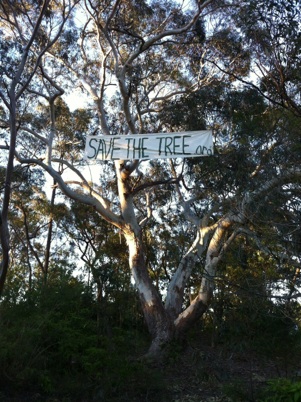 A mature native tree in a forest but on death row
so that property developers can build a house or two.
(St Georges Terrace, Faulconbridge, Blue Mountains, New South Wales Australia,
Source: ^http://savethetree.org)
.
A mature native tree in a forest but on death row
so that property developers can build a house or two.
(St Georges Terrace, Faulconbridge, Blue Mountains, New South Wales Australia,
Source: ^http://savethetree.org)
.
According the website, the subject tree has been listed on Blue Mountains Council’s Register of Significant Trees since August 1985 – #33. The subject land site where the tree stands comprises remnant bushland including the significant tree as well as three locally rare Faulconbridge Mallee Ash trees (Eucalyptus burgessiana), which is a rare species of flora included on the Australian botanical list of Rare or Threatened Plants (ROTAP).
In early 2010, a development application for two dwellings on the site was submitted to council. The proposal included the removal of a considerable amount of the remaining vegetation including the removal of the significant tree. In that same year, numerous residents submitted objections to the development application. As a result of Council’s notification process, fifteen submissions from local residents were received objecting to the development on the following bases:
- Removal of the significant tree from the site
- Clearing and loss of vegetation, including threatened
- Species of vegetation, and screening of the development
- Impacts on streetscape
- The lot should become public land
- Overdevelopment of the site and the bulk and scale of the development
- The proposed development is out of character with the surrounding development
- Proposed subdivision into 2 lots
- Loss of environmental features of the site
- Increased stormwater impacts and local flooding
- Pedestrian and traffic safety
- Reduced building setbacks
.
[Source: Blue Mountains Council, Ordinary Meeting of 28th June 2011, Section: ‘Using Land for Living’, Item 20, Ordinary Meeting, 28.06.11, p.212, 20. 11/85977. Development Application no. X/443/2010 for a detached dual occupancy consisting of a single storey dwelling and a two storey dwelling…Faulconbridge]
.
Council Planning assessed the Environmental Impacts of the proposed development as follows:
‘There are currently three (3) Faulconbridge Mallee Ash (Eucalyptus burgessiana) located on the subject allotment. This is a rare species of flora which is on the list of Rare or Threatened Plants (ROTAP) published by the CSIRO. While it is acknowledged that Eucalyptus burgessiana are a rare plant, they are not listed as a threatened species under either the Threatened Species Conservation Act or the Environmental Protection and Biodiversity Conservation Act.
‘There are also a number of other indigenous trees on the property including a large Eucalyptus Sclerophylla x Eucalyptus Piperita hybrid which is listed as a significant tree in DCP 9 Significant Trees. The proposed development will result in the removal of much of the vegetation on the site including two (2) of the Eucalyptus Burgessianna and the significant tree. The site also contains a number of significant rock outcrops which are identified by the LEP as a significant natural feature.’
.
The proposed development has been sited to avoid as far as practical impacts on those outcrops. In particular, it is noted that the development has been designed to ensure that both the dwellings and the vehicular driveways are predominantly clear of the two most significant features, being the outcrop adjacent the frontage with St Georges Crescent and the outcrop toward the centre of the lot.
Clause 44(4) provides a hierarchy for considering any adverse environmental impact which may result from any development. This clause requires that any development should be designed and sited so as to have no adverse environmental impact. However the clause goes on to provide that where an adverse environmental impact cannot be avoided and no practicable alternative is available, it is necessary to consider the proposed use of the land with reference to the zone objectives of the land. In this respect, while it would be possible to reduce the impacts if the development was confined to a single dwelling only, it is considered that there are no practicable alternatives that would allow all the rare species and the significant tree to be retained and at the same time, allow the permitted use as a detached dual occupancy.
.
It should also be noted that the significant tree has been assessed as not being viable for retention in any case as the result of extensive decay throughout the trunk. This matter is discussed in more detail in the body of the report.’
.
Biodiversity incremental degradation encouraged by Council Planners
.
The matters for consideration are:
‘ The need to prevent adverse impacts on the near pristine conditions of these subcatchments’
.
Council Planning Response:
‘The proposed development is located on an existing vacant lot within the urban area. There will be a significant amount of vegetation removal but this is unavoidable to provide for development of this site. The site will be revegetated and landscaped.’
(Editor: ‘revegetated’ permits destruction of native bushland in favour of creating an exotic urban garden complete with fertiliser and associated runoff).
Both dwellings will be connected to the sewer.
It is considered that the proposed development will not have any adverse impact on the condition of the Grose River Sub-catchment.
(Editor: What is ignored is the collective impact of multiple development applications on Blue Mountains biodiversity and catchments. The planning guidelines fails to factor the collective death by a thousand cuts).
The proposed development is located clear of the areas of surface rock on the property and has been designed to minimise cut and fill by the use of drop edge beams. While the development will result in the removal of two (2) of the Rare or Threatened Plants listed trees, the site is not part of a contiguous area of bushland and it not considered that their removal will have a significant impact on the species.’
– – –
On 28th June 2011, following Blue Mountains Council’s planning assessment, councillors voted unanimously at a General Meeting to refuse the development application on the basis that it breached Council’s local planning laws. The meeting was addressed by: Don Cameron, Robert Leslie, Rama Decent, Terry Barrett.
A motion was moved by Councillors Searle and McLaren that the Development Application No. X/443/2010 be refused on the following grounds:
- The proposed development is contrary to the objectives for the ‘Living-General’ zone under LEP 2005 in that it does not maintain and improve the character of the area, or respond to the environmental characteristics of the site;
- The proposed development, including the removal of the significant majority of existing trees and other vegetation from the site, will have an unacceptable adverse impact on the established landscape character of the locality;
- The proposed development will have an unacceptable adverse environmental impact and is contrary to the provisions of Clause 44 of LEP 2005 in that it has not been designed and sited to minimise impacts on the rare species of plant Eucalyptus Burgessiana and the destruction of rock outcrops on the property;
- The proposed two storey component of the development will be visually prominent and have an unacceptable impact on the existing streetscape when viewed from St Georges Crescent;
- The proposed development is an over development of the site in terms of the height, bulk and scale of the two storey dwelling fronting St Georges Crescent;
- The proposed development does not comply with Clause 2, Part 1, Schedule 2 – Locality Management within the Living Zones, of LEP 2005 by reason that the rear dwelling encroaches onto the 4 metre secondary street frontage setback to Adeline street, and the Council is not satisfied that the objection lodged pursuant to State Environmental Planning Policy No 1 is well founded or that compliance with the standard is unreasonable or unnecessary in the circumstances;
- The proposed stormwater management measures proposed are not adequate, given the potential run-off from the proposed development of the land as a dual occupancy; and Confirmed Minutes Ordinary Meeting 28 June 2011, p.21 of 28
- The grant of development consent will be contrary to the public interest.
.
Upon being put to the Council meeting, the motion was carried unanimously.
Not content with this unanimous decision, the owners of the site appealed against the Council democratic umpire, and in September 2011 the appeal case was heard by The Land & Environment Court of New South Wales.
Specialist arborists gave conflicting reports on the health and viability of the said tree, perhaps according to their respective client motivations. Yet the arborists of opposing parties were engaged as expert witnesses of the Court and so legally presumed to be independent. But legal presumption conveniently ignores contractual undertaking, so the evidence was likely biased to the respective parties.
In the interim findings, the Acting Senior Commissioner agreed that the tree could be removed, notwithstanding its status as a Significant Tree. (Editor: for whose convenience?)
A final ruling on the case will be made after the applicants have submitted a complying landscape plan. One won’t be surprised if the ultimate outcome is from dense mature intact bush to a clearfelled, bulldozed site, and the Court will somehow justify this in favour of the property owners as it normally does.
More information and analysis on this case will be presented in future.
.
.
Further Reading:
.
[1] ‘ The Idea of Wilderness: From Prehistory to the Age of Ecology’, by Max Oelschlaeger, ^ http://yalepress.yale.edu/book.asp?isbn=9780300053708
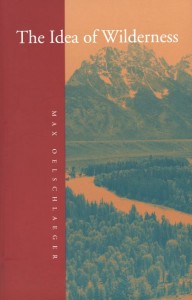 ‘How has the concept of wild nature changed over the millennia? And what have been the environmental consequences? In this broad-ranging book Max Oelschlaeger argues that the idea of wilderness has reflected the evolving character of human existence from Paleolithic times to the present day. An intellectual history, it draws together evidence from philosophy, anthropology, theology, literature, ecology, cultural geography, and archaeology to provide a new scientifically and philosophically informed understanding of humankind’s relationship to nature. ‘How has the concept of wild nature changed over the millennia? And what have been the environmental consequences? In this broad-ranging book Max Oelschlaeger argues that the idea of wilderness has reflected the evolving character of human existence from Paleolithic times to the present day. An intellectual history, it draws together evidence from philosophy, anthropology, theology, literature, ecology, cultural geography, and archaeology to provide a new scientifically and philosophically informed understanding of humankind’s relationship to nature.
Oelschlaeger begins by examining the culture of prehistoric hunter-gatherers, whose totems symbolized the idea of organic unity between humankind and wild nature, and idea that the author believes is essential to any attempt to define human potential. He next traces how the transformation of these hunter-gatherers into farmers led to a new awareness of distinctions between humankind and nature, and how Hellenism and Judeo-Christianity later introduced the unprecedented concept that nature was valueless until humanized. Oelschlaeger discusses the concept of wilderness in relation to the rise of classical science and modernism, and shows that opposition to “modernism” arose almost immediately from scientific, literary, and philosophical communities. He provides new and, in some cases, revisionist studies of the seminal American figures Thoreau, Muir, and Leopold, and he gives fresh readings of America’s two prodigious wilderness poets Robinson Jeffers and Gary Snyder. He concludes with a searching look at the relationship of evolutionary thought to our postmodern effort to reconceptualize ourselves as civilized beings who remain, in some ways, natural animals.’
.
[2] Save Our Suburbs, ^ http://www.sos.org.au/
.
[3] Save The Tree, ^ http://savethetree.org
.
Tags: act locally, an inconvenient truth, Blue Mountains, Blue Mountains City Council, bushphobia, civilisation, conurbation, David Brower, deluded inconvenience, Emilie Travel Livezey, environmental destruction, Eucalyptus burgessiana, Eucalyptus sclerophylla, Faulconbridge, Faulconbridge Mallee Ash, FOE, Friends of the Earth, globalisation, Greater Blue Mountains World Heritage Area, Grose River Sub-catchment, housing encroachment, industrial progress, industrialisation, local character, local residents, Mother Nature, Mount Wellington, NIMBYism, Not In My Backyard, Queenstown, Rare or Threatened Plants (ROTAP), revegetated, rights of locals, Save Our Suburbs, savethetree.org, Significant Tree, Sir Patrick Geddes, Tasmania, terra incognita, The Land & Environment Court of New South Wales, think globally, urban consolidation, wilderness
Posted in Blue Mountains (AU), Tasmania (AU), Threats from Development, Threats from Greenwashing, Threats from Weak Environmental Laws | No Comments »
Add this post to Del.icio.us - Digg
Leave a Reply
You must be logged in to post a comment.
December 7th, 2011
The following article was ‘borrowed’ from CanDoBetter.net under the title ‘The Tarkine Wilderness under threat‘ by author Vivienne Ortega dated 20111207:
.
‘Tasmania’s Tarkine Wilderness Endangered!’
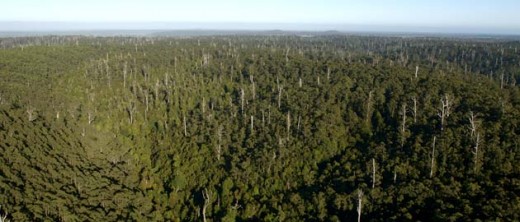 The Tarkine region is located in the north-west of Tasmania. The area encompasses 447,000 hectares of wilderness including the Southern Hemispheres largest single tract of temperate rain forest, a wild coastline with an extraordinary wealth of Aboriginal Cultural Heritage sites. It’s the habitat for over 50 threatened species. The extensive rainforests, beautiful river gorges, buttongrass mountain tops, flowering heathlands and long wild beaches combine to make the Tarkine one of the world’s great treasures. The Tarkine region is located in the north-west of Tasmania. The area encompasses 447,000 hectares of wilderness including the Southern Hemispheres largest single tract of temperate rain forest, a wild coastline with an extraordinary wealth of Aboriginal Cultural Heritage sites. It’s the habitat for over 50 threatened species. The extensive rainforests, beautiful river gorges, buttongrass mountain tops, flowering heathlands and long wild beaches combine to make the Tarkine one of the world’s great treasures.
These rainforests are important for their flora which has links to the ancient continent of Gondwana, and for their lichens and fossils which help tell the story of Australia’s ancient flora and its evolution. The Tarkine is a sensitive region rich in mega-diversity. It’s one of the world’s last remaining temperate rain-forests, the home of the Tasmanian Devil and many other precious species.
.
Tarkine National Heritage a must
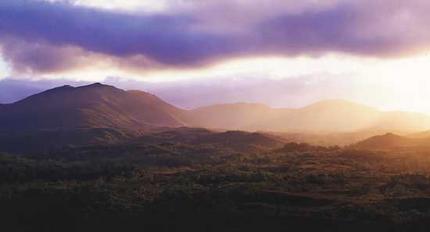 How many places on Earth still look like this?
What an incredible asset of eco-experience (not dodgy eco-tourism) wild Tasmania offers the world’s discerning explorer? How many places on Earth still look like this?
What an incredible asset of eco-experience (not dodgy eco-tourism) wild Tasmania offers the world’s discerning explorer?
.
The Tarkine must be put on the National Heritage List. The heritage assessment of The Tarkine will help ensure that the heritage values are considered in decision-making, so heritage protection is balanced with the social and economic aspirations of the Tasmanian community. Short-term economic benefits should not be at the expense of the un-quantifiable value of ancient woodlands, rugged coastlines, and forest habitat destruction. Mining companies like Venture Minerals are desperate to exploit the minerals beneath Tasmania’s environmentally significant Tarkine area.
 Enter the Tin Men Enter the Tin Men
.
Demand for metals superior to Tasmania’s ecology?
.
Chinese demand for base metals such as gold, iron, tin, zinc, lead, copper is at an all time high, and this would mean logging, pollution, roads, and heavy traffic destroying the landscape and pristine rivers.
Environment Minister Tony Burke was called on to immediately include the Tarkine on the emergency National Heritage Listing amid concerns about the impact on the Tasmanian devil population of a revised tourist road project. He denied that he made a promise to do so. His predecessor, Peter Garrett, first gave the Tarkine wilderness a one-year emergency listing, which Mr Burke let expire. Since then he has let a British mining company test drill in the area. Mr Burke says the new plan for a tourist road is not the same as the original 132-kilometre loop road plan that was subject to a now lapsed emergency listing. One road is not similarly destructive an another? Mining and road proposals threaten to carve up Tasmania’s unprotected the Tarkine wilderness area, local defenders say.
Venture Mineral’s Mt Lindsay tin, tungsten and iron mining proposal, coupled with the revival of the controversial Tarkine link road proposal, should have given Mr Burke grounds to reinstate Tarkine’s emergency National Heritage listing. Heritage listings would not stop mining, but developments would have to pass more rigorous and critical environmental tests.
The Mount Lindsay tin project is the largest of several mines planned around the Tarkine in an emerging new Tasmanian environmental battle. The Tarkine National Coalition said up to nine new open cut mines are in development there. Venture Minerals predict $1 billion in revenue, with more than 500 jobs in construction and 200 in operation. Surely the threats of mining are enough reasons for an emergency heritage listing for the Tarkine?
Mr Burke says the principle that a heritage listing automatically locks out all development is wrong. He says with or without a heritage listing, environmental protection remains. “Developments” and “protection” are inherently contradictory. Mr Jordan who heads the Tarkine National Coalition says Mr Burke’s decision to lift the heritage listing means other mining companies will not be scrutinised as closely as Beacon Hill Resources. The whole area should be protected as a national park.
The interests of miners are being placed above the Minister’s obligations to the environment. All three proposed mining projects will have secured Commonwealth environmental permits during the 18 month period he had at his disposal, allowing them to avoid scrutiny against National Heritage criteria. They will also be allowed to continue exploration drilling and associated access roading without need for Commonwealth assessments.
The mining will cause havoc to the pristine condition of the area. There is nothing “sustainable” now. It’s just window-dressing. What about the costs and long term damage of these industries and jobs? Mr Burke is supposed to represent the environment, not the mining industries. As with his population strategy, that come to nothing, he is now abrogating his duty to protect one of the last temperate rain-forest areas in the world.
.It is wrong to destroy sacred and holy places to plunder their riches, and the same applies to Nature’s sacred places.
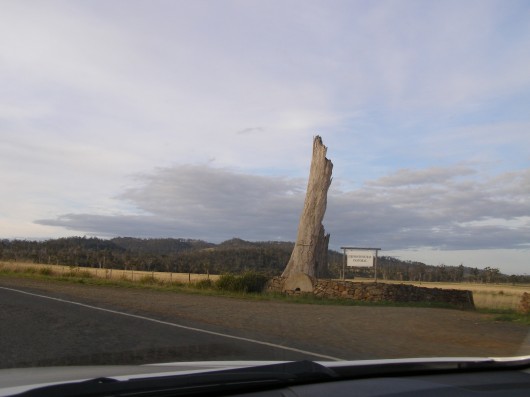 A proud colonial relic of a Tasmanian old growth forest raped, pillaged and plundered
…and today colonial logger descendants, hanging on to the past, are paupers.
(Photo by editor 20110928, free in public domain – click to enlarge, then click to enlarge again) A proud colonial relic of a Tasmanian old growth forest raped, pillaged and plundered
…and today colonial logger descendants, hanging on to the past, are paupers.
(Photo by editor 20110928, free in public domain – click to enlarge, then click to enlarge again)
.
.
Please email a demand to the ultimate decision maker of our temporary time:
Australia’s current Environment Minister: Tony.Burke.MP@aph.gov.au
.
Leave a Reply
You must be logged in to post a comment.
December 5th, 2011
The following comments were posted by Tigerquoll 20111102, on Tasmanian Times to the article ‘Tasmania’s longest running forest blockade celebrates 5-year milestone‘, by Miranda Gibson, Still Wild Still Threatened (20111101), which began…
.
‘Today “Camp Flozza” celebrates its fifth birthday. The forest blockade has been running continuously for the past five years, holding off logging operations in the Upper Florentine Valley’. [Read More].
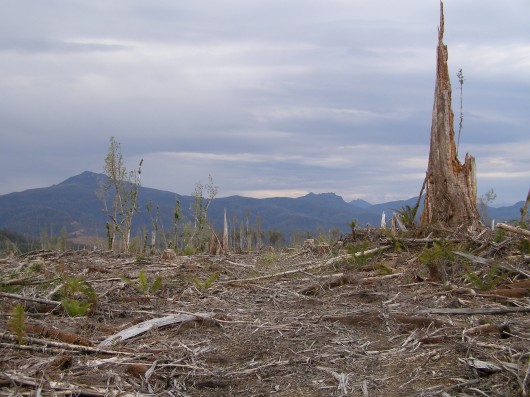 Styx Valley Holocaust
– old-growth clearfelled by Forestry Tasmania
(Photo by editor 20110929 – free in public domain)
(Click photo to enlarge, then click again to enlarge again) Styx Valley Holocaust
– old-growth clearfelled by Forestry Tasmania
(Photo by editor 20110929 – free in public domain)
(Click photo to enlarge, then click again to enlarge again)
.
“A Conservation Agreement halting logging in 430,000 hectares is now over-due. The Intergovernmental Agreement signed in August explicitly states that logging operations must be rescheduled or where this is not possible compensation given. Every hectare of forest lost in this area now represents a complete breach of the promises made by the government.”
.
~ Miranda Gibson, Still Wild Still Threatened
.
.
Of old growth defenders:
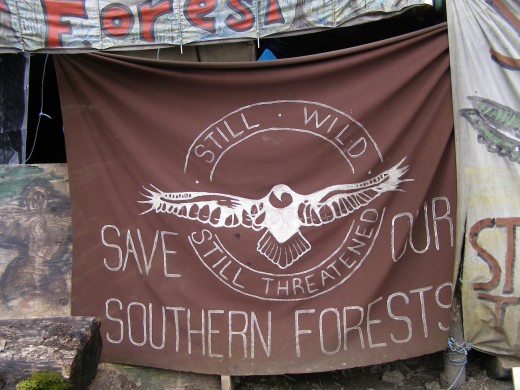
“Here’s to the crazy ones, the misfits, the rebels, the troublemakers, the round pegs in the square holes… the ones who see things differently—they’re not fond of rules… You can quote them, disagree with them, glorify or vilify them, but the only thing you can’t do is ignore them because they change things… they push the human race forward, and while some may see them as the crazy ones, we see genius, because the ones who are crazy enough to think that they can change the world, are the ones who do.”
~ Steve Jobs [1955-2011]
History will recount – the steadfast commitment by these forest defenders to hold their ground, to dig in, in the face of an overwhelming enemy, compares to the dusty amateurs that became the rats of Tobruk.
.
Of old growth rapers:
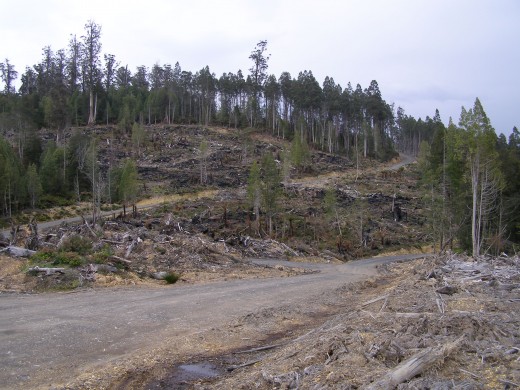 Styx Valley hillside clearfelled – beyond Forestry Tasmania’s locked gates.
(Photo by editor 20110929 – free in public domain)
(Click photo to enlarge, then click again to enlarge again) Styx Valley hillside clearfelled – beyond Forestry Tasmania’s locked gates.
(Photo by editor 20110929 – free in public domain)
(Click photo to enlarge, then click again to enlarge again)
.
A morally-wise person would not put down an animal because it was injured. Moral civilized society has evolved the ‘Veterinary’ profession – a highly skilled field, more highly qualified than human ‘General Practice Medicine’ – why?
In the wild, a female mammal may kill an impaired offspring only to save its remaining healthy young scarce food to survive.
In Tasmania, old growth forests are becoming scarcer by the day, and yes this is still occuring in the 21st Eco-Century, not the 19th Timbergetting Century.
But in the selfish eyes of industrial loggers, any broken branch justifies the clearfell and scorched earthing of old growth forests by the hectare, which are innocuously relegated as ‘coupes’.
What then is a coupe? A forest coupe is earmarked for logging. A selected section of an intact, pristine native old growth forest is earmarked by Forestry Command for ‘harvesting‘, read ‘logging‘, read ‘forest ecology slaughter‘, read ‘forest wildlife habitat destruction‘. Yet to the logger mind forest reads as plunderable timber, and these days as low grade commodity woodchip to greedy asian profiteers, only to sustain a diehard, got-no-where-to-go desperate logger culture. The log-till-I-drop logger mentality is no different to morbidly obese American juveniles confessing dependence on Maccas Big Macs.
I fear loggers would do same to their grandparents once impaired.
‘Corporate industrialism’ is worse than Herbert Spencer’s ‘survival of the fittest’ mindset. It is self-serving Forest Eugenics – evident in Forestry Tasmania’s programmed conversion of native Tasmania into plantations and the scourge of its genetically modified Eucalyptus nitens now exterminating Tasmania’s next condemned species – the Tasmanian Devil.
Beware the Forest Nazis lurking in the privets.
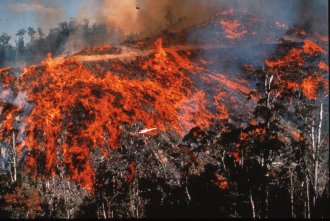
Holocaust is what the Nazis did
This is what Forestry Tasmania did recently to The Tarkine.
.
 ‘Forest Eugenics’ is what Forestry Tasmanian ‘scientists‘ are doing today – ‘Forest Eugenics’ is what Forestry Tasmanian ‘scientists‘ are doing today –
GM-modified Eucalypt nitens plantations replacing native Old Growth
.
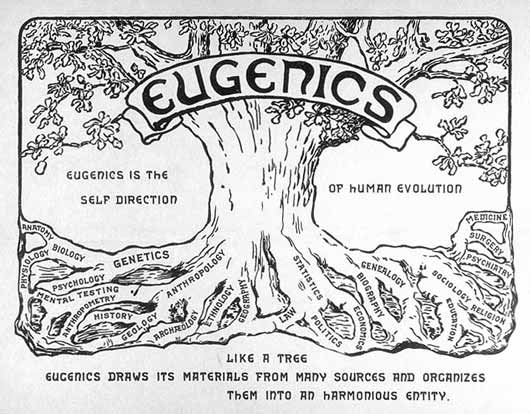 Is this where GM Nitens (shining gum) is taking Tasmanian ecology – to ‘elite forests’?
– superior growth rate, disease resistant, herbicide resistant, but perhaps the GM-exterminator of Tasmanian Devils. Is this where GM Nitens (shining gum) is taking Tasmanian ecology – to ‘elite forests’?
– superior growth rate, disease resistant, herbicide resistant, but perhaps the GM-exterminator of Tasmanian Devils.
.
Tags: Camp Flozza, Eucalyptus nitens, Forestry Tasmania, Intergovernmental Agreement, Logging, old growth, Still Wild Still Threatened, Styx Valley Holocaust, Tasmania, Tasmanian forest eugenics, Tasmanian Times, The Tarkine, Upper Florentine Valley
Posted in Tasmania (AU), Threats from Deforestation, Threats to Wild Tasmania | No Comments »
Add this post to Del.icio.us - Digg
Leave a Reply
You must be logged in to post a comment.
December 4th, 2011
“..this awe-inspiring, largely unknown part of Australia – a wilderness that has survived, virtually untouched, for over 65 million years from its Gondwana heritage, but which is today under increasing threat from Man.”
.
~ Robert Purves, June 2010, in Foreword of the book ‘The Tarkine’, edited by Ralph Ashton and published by Allen & Unwin, [Available at ^http://www.allenandunwin.com/default.aspx?page=94&book=9781742372846]
.
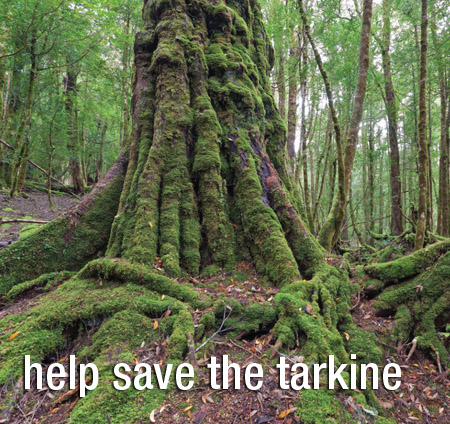 The Tarkine’s mystical beauty of an ancient Giant Myrtle (Nothofagus cunninghammii) The Tarkine’s mystical beauty of an ancient Giant Myrtle (Nothofagus cunninghammii)
.
Urgent press releases from the local champions trying to save The Tarkine:
.
.
‘New threats to the Tarkine’
.
(Source: The Wilderness Society, Tasmania, ^http://www.wilderness.org.au/regions/tasmania/new-threats-to-the-tarkine)

We all know the Tarkine is an environmental jewel – but when mining companies look at this special place, they see the glint of valuable metals instead. Gold, iron, tin, zinc, lead, copper – you name it and chances are it can be found in the mineral-rich bedrock beneath the Tarkine.
With Australia in the grip of an extraction bonanza, and Chinese demand for base metals at an all time high, the pressure to open up the Tarkine to mining is building. So far, 12 mines have been proposed for the Tarkine over the next two years, along with 56 licences for mineral exploration in the area. If even a fraction of these mines go ahead, this wild land of rugged coastline, pristine rivers and forested hills could be compromised – criss-crossed with exploration tracks and roads and dotted with waste dumps, pits and trenches.
The Tarkine is of huge environmental significance. It is one of the largest remaining tracts of temperate rainforest on earth, and home to a huge variety of species including:
- Tasmanian devils
- Tasmanian wedge- tailed eagles
- Spotted-tailed quolls
- Southern bell frogs
- White goshawks
- Giant freshwater lobster
- Eastern barred bandicoots
- Orange-bellied parrots
- and the Huon pine.
.
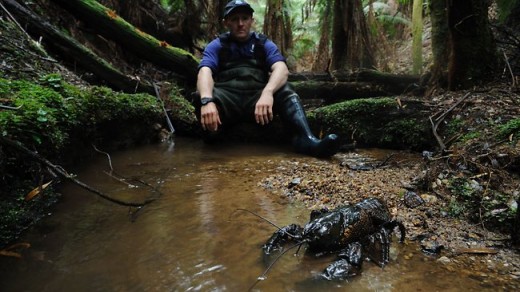 Tasmania’s Giant Freshwater Lobster (Astacopsis gouldi)
It is found only in northern Tasmanian streams (particularly in The Tarkine) and rivers flowing into Bass Strait.
It is found nowhere else in the world, yet is threatened by illegal fishing, land clearing and forestry.
(Source: Matthew Denholm, Tasmania Correspondent, The Australian, 20111109) Tasmania’s Giant Freshwater Lobster (Astacopsis gouldi)
It is found only in northern Tasmanian streams (particularly in The Tarkine) and rivers flowing into Bass Strait.
It is found nowhere else in the world, yet is threatened by illegal fishing, land clearing and forestry.
(Source: Matthew Denholm, Tasmania Correspondent, The Australian, 20111109)
[Read Recovery Plan]
.
Environmental jewel
The Tarkine’s wild, rugged coastline – there’s no land between this point and the South American coast – boasts some of the cleanest air in the world. Because of these values (above ground), the Tarkine has long been the subject of a community-driven National Park proposal. In addition, in 2010, a report by the Australian Heritage Commission recommended that 430,000 hectares of the Tarkine be granted National Heritage status.
But Environment Minister Tony Burke has refused to implement this recommendation, claiming a need for further assessment and consultation. For decades, environmentalists have been working to protect the Tarkine. Some campaigns have been lost – like the road to nowhere in the mid 1990s – others have been won. Now, with the Tasmanian Forest Agreement progressing, it looks like the area may at last be protected from logging.
.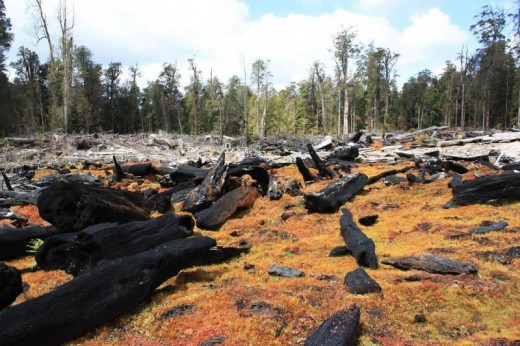 Logging and ‘scorched earthing’ of old-growth rainforest in The Tarkine
(October 2009, Environment Tasmania) Logging and ‘scorched earthing’ of old-growth rainforest in The Tarkine
(October 2009, Environment Tasmania)
.
But mining remains as a threat in this pristine region.
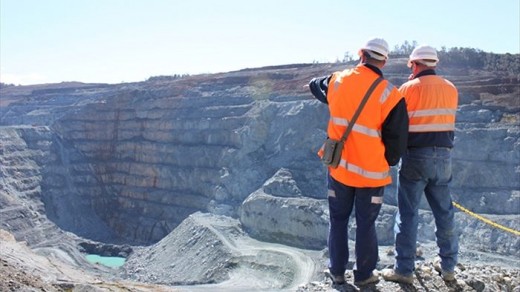 Savage River Open Cut Mine in the north of The Tarkine Savage River Open Cut Mine in the north of The Tarkine
.
It’s not hard to predict what will happen over the coming months: mining companies will pressure the Tasmanian Government to allow these mines to go ahead, dressing their arguments up in the usual disguise by claiming that mining is essential for jobs.
But putting industry ahead of the environment is an approach that has failed for decades and a new approach is needed. The Wilderness Society is involved with a coalition of groups calling for the creation of a Tarkine National Park.
With your support, the Wilderness Society will be standing up for an Australia that values the Tarkine not for the metals that can be extracted by destroying it, but for the precious environmental qualities that it has when left intact.
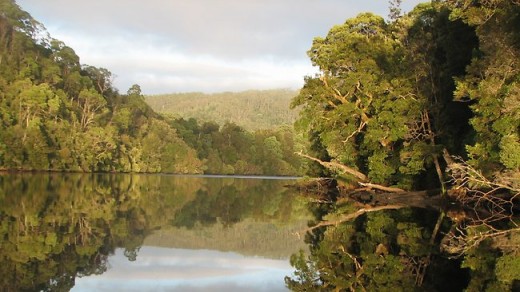
.
‘Burke’s broken promise misleads the public’
.
(by Scott Jordan, Campaign Coordinator, Tarkine National Coalition, 20111202, Tasmanian Times online newspaper, ^http://tasmaniantimes.com/index.php?/weblog/article/burkes-broken-promise-misleads-the-public/)
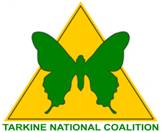
‘Tarkine National Coalition has reacted angrily to the latest chapter in Environment Minister Tony Burke’s campaign of misinformation regarding the Tarkine National Heritage assessment. The Minister made comment on ABC Mornings (936 Tasmania) that he did not have in his possession any report from the Australian Heritage Council supporting a permanent listing of the Tarkine.
This is at odds with our reading of the Australian Heritage Council report from September 2010 which supported the permanent listing of 433,000 hectares it had assessed as having National Heritage Values. Minister Burke has refused to publicly release this report, despite FOI requests from the ABC last year.
“The Minister is clearly failing in his responsibilities here, and is spinning mistruths to try and cover up his complicity in promoting mining in the Tarkine wilderness reserves,” said Tarkine National Coalition spokesperson Scott Jordan.
The Minister received this report two months before allowing the Tarkine’s Emergency National Heritage Listing to lapse. He then sent the AHC back to reassess the area, with a substantial budget cut and no capacity to complete the work before 2013. This will effectively shepherd up to ten new mine proposals through an EPBC process that cannot in the absence of a listing, legally consider impacts on National Heritage Values such as wilderness, rainforest, geological significance (fossil sites and karst systems), aesthetic character, Indigenous or European cultural heritage.
This mirrors the strategy applied by the Minister at the controversial Brighton By-pass in southern Tasmania and at James Price Point in northern WA, where once EPBC assessments were underway, a National Heritage Listing was applied that could have no legal effect on those ongoing assessments.
Independent advice from Andrew Macintosh, Associate Director of the ANU Centre for Climate Law and Policy confirms that the AHC report does in fact refer to a permanent listing, and advises that the AHC’s terms of reference only allow it to report on whether an area has National Heritage Values and prevents it from making ‘qualified’ or ‘preliminary’ findings. The correspondence from Mr Macintoshcan be downloaded below..
“It becomes impossible to have reasonable dealings with a Minister who won’t stick to the rules, and won’t tell the truth”. “The Minister must immediately release the Australian Heritage Council’s Tarkine report from September 2010”.
.
Emergency National Heritage Listing
The TNC and partner groups (WWF, Australian Conservation Foundation, The Wilderness Society, Tasmanian Conservation Trust, Environment Tasmania and North West Environment Centre) resubmitted a Emergency National Heritage Listing nomination last week, triggered by the threats to National Heritage Values of the Mount Lindsay and other mining proposals.

The resubmitting of the Tarkine Road proposal by the Tasmanian Government called into play a promise made by Minister Burke last December that if the Tarkine Road was resubmitted, that he would immediately re-list the Tarkine. The Minister has failed to deliver on this promise.
“The failure to reapply a Tarkine Emergency National Heritage Listing in response to the Tarkine Road referral clearly shows this Minister’s contempt for the responsibilities of his office, and clearly tells us that any promises he makes are worthless”.
“The key difference between this proposal and the former proposal is not the alterations to the route, but the fact that a mining company now needs this route for transporting product to ports”.
.
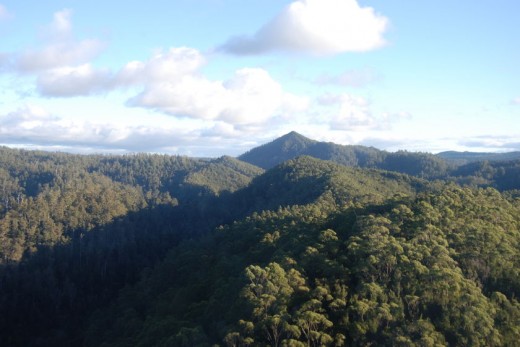
.
.
‘Burke places money and mines before Tarkine’
.
by Senator Christine Milne, Tasmanian Times online newspaper, ^http://tasmaniantimes.com/index.php?/weblog/article/burkes-broken-promise-misleads-the-public/]
.
Federal Environment Minister, Tony Burke, must explain why he will allow the assessment of mining proposals to occur in the Tarkine before acting on advice before him to permanently heritage list the region, Australian Greens Deputy Leader, Christine Milne said today.
“Minister Burke today claimed on ABC local radio to have no information leading to the emergency heritage listing of the Tarkine, but failed to mention a report buried in his department recommending the Tarkine be listed.
“The Environment Minister is playing into the hands of mining companies, who are no doubt jubilant of the 2013 deadline given to the Australian Heritage Council to determine whether permanent heritage listing should be put in place.
“By 2013, all ten of the mining proposals will be submitted to the department and any subsequent heritage listing will have no effect on their operations. The wilderness, geological and cultural values of the Tarkine will not be assessed.
“It is like putting on a seatbelt after your car has crashed.
“Minister Burke’s job has moved from a focus on natural and heritage values to one of being solely concerned with bleeding monetary value from the places he is supposed to protect.
“Peter Garrett placed emergency heritage listing on the Tarkine following the state government’s previous attempt at building a road, and now, with a similar application before him, as well as ten mining applications that will be seriously impinged by such a listing, we have Minister Burke reneging on his promise to heritage list the region should another road proposal be made.
“This ongoing, seven year process to determine heritage listing the Tarkine has become an embarrassment to Australia whose governments persistently fail to recognise the value of this natural jewel.
.
“Minister Burke has everything at his disposal for immediately placing the Tarkine on the National Heritage list.
Act now, Minister Burke, before these mines have your name all over them.”

Tasmania as seen by miners – exploitative ‘below-ground’ values
.
Selected comments readers of Tasmanian Times:
.
by Barnaby Drake (20111202):
“The key difference between this proposal and the former proposal is not the alterations to the route, but the fact that a mining company now needs this route for transporting product to ports”.
‘Is it not just as I predicted? All infrastructure for these mining companies will be paid for by us. Here the original estimate was for $24 Million as a starters. Expect the real cost to be dramatically understated so that they can get their approval before announcing the usual blow-out! And that’s just the start of it. That also means that the Tourism budget will take the hit, but strangely, Forestry will also be able to us this road as the Tarkine is no longer protected. It will then be discovered by TasPorts that they need to upgrade their port facilities somewhere in the West to benefit the local inhabitants and they require another Sqillion Dollars and of course, create a couple of thousand jobs, etc.
Hallelujah! The economy has been saved. Your pensions are safe. A new mining tax will see us all happy and prosperous and MP’s will be able to have their blocked salary increases paid. A replay of the famous once Gunns proposals.
All we need now is an education bus to train the kiddies for the future. Utopia!’
.
by John Hayward (20111202):
‘The Minister would see his responsibility as being to himself, his party, and to their major political contributors. His apparent dishonesty, or ignorance, is merely a consequence of these priorities.’
.
by Russell Langfield (20111202):
‘Can anyone name a promise Environment Minister Burke has kept, or a decision being made which favoured the environment over business interests?’
.
Salamander (20111202):
‘Burke likes to make out he is a man of the people, and responds when he gets enough signals from the people to act for the environment. Yesterday he was complaining about the hijacking of his twitter account by tweets about the Tarkine – but still he won’t do what the people want. Seems to me we have a puppet whose strings are completely controlled by corporations.’
.
by Pete Godfrey (20111203):
‘There is no money for hospitals, police, mobile phones for police, anything that is good for people, but there is always money available for Forestry and Mining. From what I can recall every mine venture that has received grants from the government has failed. All we ever get back is the privelege of cleaning up the mess and a hole in the ground. Part of the Tarkine have already been destroyed comprehensively by Forestry Tasmania, it is time to protect the rest from both of these rapacious subsidy collectors.’
.
by Pete Godfrey (20111203):
‘Unless you count building a road for Mining and Logging access to the area as a grant. I do.
What will happen is that he industry will start up, then say “oh it is not viable without some subsidies” then we put our hand in the the till and hand over heaps of money. Just like all the other mining ventures on the west coast. The companies accept the money then close the mine down not long after.
You can guarantee that the government will pay in the end.
We will pay for the new “mining and forestry road”
We will upgrade port facilities.
We will pay for road damage and bridge damage. Which is what the original Tarkine loop road proposal was about, it was to rebuild two bridges that have washed away before, the Tayatea bridge being one of them.
We may not hear of incentive grants to attract the miners but you can bet that a certain minister from the west will be handing grants out like lollies.’
.
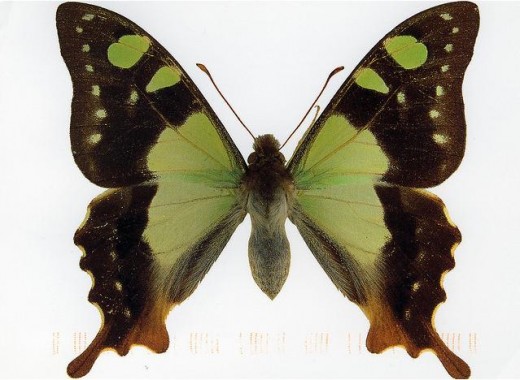 Maclays Swallowtail (Graphium Macleyanum), a native to The Tarkine
© Photo by Marja-Liisa, Helsinki (‘mliisa’s photostream’ on flickr, AU-2100 from Lynette,
^http://www.flickr.com/photos/25816219@N00/1921054368/ Maclays Swallowtail (Graphium Macleyanum), a native to The Tarkine
© Photo by Marja-Liisa, Helsinki (‘mliisa’s photostream’ on flickr, AU-2100 from Lynette,
^http://www.flickr.com/photos/25816219@N00/1921054368/
.
‘If the Tarkine were to be joined to the world heritage area, a vast reserve would be created, stretching from just a few kilometres south of Tasmania’s north coast all the way to its south-western extremity.
If this were to happen, it would, in my opinion, be among the top half-dozen natural areas remaining in the world. And properly managed, it would bring wealth to Tasmanians into the foreseeable future.’
.
~ Tim Flannery, contribution in ‘The Tarkine‘ (2010), edited by Ralph Ashton, and published by Allen & Unwin.
.
Tags: Australian Heritage Council, Giant freshwater lobster, National Heritage, National Park proposal, old growth forest, Savage River Open Cut Mine, save the Tarkine, scorched earthing, Tarkine National Coalition, Tarkine National Heritage, Tarkine National Park, Tarkine’s Emergency National Heritage Listing, Tasmania, Tasmanian Government, The Tarkine, Tony Burke
Posted in Tasmania (AU), Threats from Deforestation, Threats from Mining, Threats from Road Making, Threats to Wild Tasmania | No Comments »
Add this post to Del.icio.us - Digg
Leave a Reply
You must be logged in to post a comment.
December 3rd, 2011
The following article was first published in the Blue Mountains Gazette newspaper 20060122:
.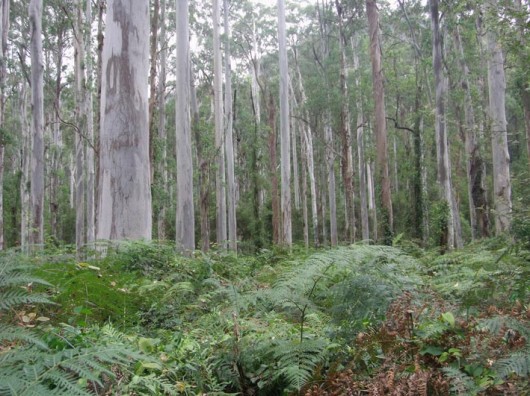 Blue Gum Forest, Grose Valley, Blue Mountains
[Source: AK Bushwalks, ^http://mywebdots.com/bushwalks/?page_id=26] Blue Gum Forest, Grose Valley, Blue Mountains
[Source: AK Bushwalks, ^http://mywebdots.com/bushwalks/?page_id=26]
.
A tall moist open forest dominated by Blue Gum (Eucalyptus deanii) characterises the famous ‘Blue Gum Forest’ at the junction of the Grose River and Govetts Creek in the Grose Wilderness.
But there would be no Blue Gum Forest if it were not for the efforts of a dedicated band of very fit bushwalkers seventy odd years ago. In 1931, under the leadership of Myles Dunphy, the ‘save Blue Gum Forest’ campaign was ignited by the threat by a leaseholder on the Grose River/Govetts Creek junction wanting to clear the icon stand of tall blue gums for cattle grazing. Consisting of members of the Wildlife Preservation Society, the Sydney Bush Walkers and the Mountain Trails Club, they formed the Blue Gum Forest Committee. Hard campaigning secured purchase of the forest for £130, which they handed back to the Crown and on 2nd September 1932 was proclaimed a recreation reserve. They unknowingly in their bold defence of the Blue Gum Forest, established what has become known as Australia’s ‘cradle of conservation‘.
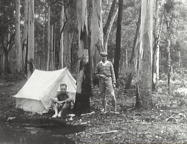
It took another 27 years of wilderness campaigning for The Blue Mountains National Park to be proclaimed in 1959 and the Blue Gum Forest incorporated two years later.
Despite deserved World Heritage listing in 2000, the Grose has again come under threat. This time last year, tonnes of caramel sediment from highway upgrade stockpiling at Leura started choking Govett’s Creek. Seems the RTA simply underestimated Mountains weather.
To the credit of Leura residents, grassroots leadership has again emerged to defend the Grose and to hold the RTA accountable. A year hence, council has responded with a working party to develop remedial actions, although ‘in-creek’ action remains wanting. Abundant photographic evidence and a moral obligation warrant the RTA fund ecological remediation.
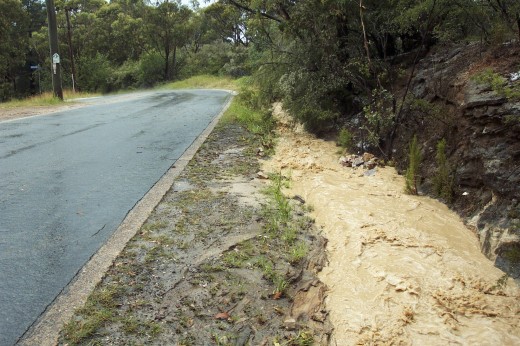 Caramel-coloured construction sediment from the RTA’s Trucking Expressway
Leura, Blue Mountains 2006
(click photo to enlarge, the click again to enlarge again) Caramel-coloured construction sediment from the RTA’s Trucking Expressway
Leura, Blue Mountains 2006
(click photo to enlarge, the click again to enlarge again)
.
But where was the custodial manager of the Grose while the damage was being reported? The Department of Environment and Conservation (National Parks) and the environmental enforcer (the EPA) have been conspicuously muted to environmental breaches caused by their sister government agency.
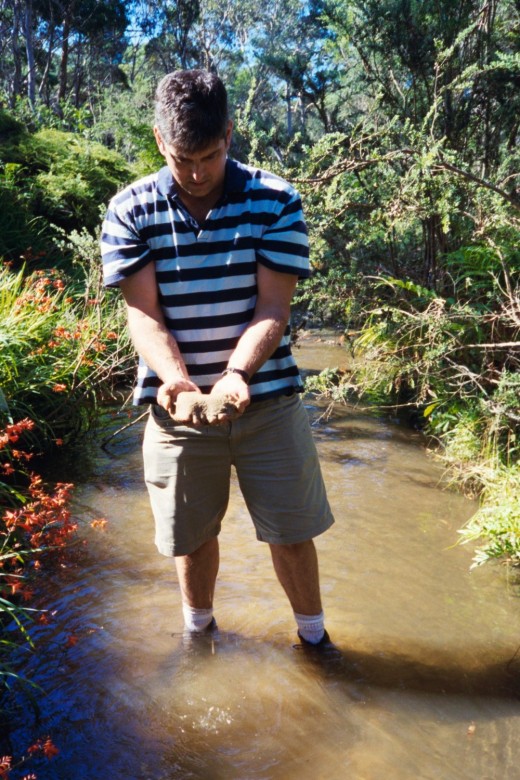 RTA sediment from the upstream Trucking Expressway development
polluting Govetts Creek inside the Blue Mountains World Heritage Area.
Photo of Editor in Govetts Creek, Leura, Blue Mountains 2006 RTA sediment from the upstream Trucking Expressway development
polluting Govetts Creek inside the Blue Mountains World Heritage Area.
Photo of Editor in Govetts Creek, Leura, Blue Mountains 2006
.
Tags: Blue Gum, Blue Gum Forest, Blue Mountains National Park, Cradle of Conservation, creek polluton, EPA, Eucalyptus deanii, Govetts Creek, Grose River, Grose Valley, highway sediment pollution, RTA Blue Mountains, trucking expressway, Wildlife Preservation Society
Posted in Blue Mountains (AU), Threats from Road Making | Comments Off on Grose Leadership
Add this post to Del.icio.us - Digg
December 3rd, 2011
This article was initially published by Tigerquoll 20090622 onCanDoBetter.net under the article title ‘Rees’ ‘red hot go’ hunting in our National Parks‘. It has been modified somewhat.
.
New South Wales Premier Rees is set to pass into law a ‘Game and Feral Animal Control Amendment Bill 2009‘ to permit recreational hunters shooting everything and anything in protected National Parks across NSW, including native wildlife.
Controlling feral animals is a science, not a sport. Rees’ passion for sport is compromised by influential cronies and naivety. Problem is: Rees has no knowledge, experience in or aptitude for science. His inaugural “red hot go” says it all and threatens to be his legacy.
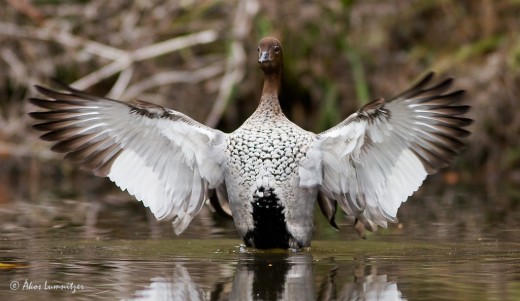 Australian Wood Duck (Chenonetta jubata) Australian Wood Duck (Chenonetta jubata)
(a native species not protected)
©Photo by Ákos Lumnitzer (with permission), ^http://www.amatteroflight.com/
.
Be clear, the Game and Feral Animal Control Amendment Bill 2009, Schedule 3, Part 2 lists the following Australian native fauna as free ‘game‘, including:
.
Native Ducks:
Australian Shelduck (or Mountain Duck) (Tadorna tadornoides)
Australian Wood Duck (or Maned Duck) (Chenonetta jubata)
Black Duck (or Pacific Black Duck) (Anas superciliosa)
Blue-winged Shoveler (or Australasian Shoveler) (Anas rhynchotis)
Chestnut Teal (Anas castanea)
Grass Duck (or Plumed Whistling Duck) (Dendrocygna eytoni)
Grey Teal (Anas gibberifrons)
Hardhead Duck (or White-eyed Duck) (Aythya australia)
Pink-eared Duck (Malacorhynchus membranaceus)
Water Whistling Duck (or Wandering Whistling Duck, Whistling or Wandering Tree Duck) (Dendrocygna arcuata)
Native Quails:
Brown Quail (Coturnix ypsilophora)
Stubble Quail (Coturnix pectoralis)
Native Birds:
Australian White Ibis (Threskiornis molucca)
Black Swan (Cygnus atratus)
Common Bronzewing Pigeon (Phaps chalcoptera)
Galah (Eolophus roseicapilla)
Little Corella (Cacatua sanguinea)
Long-billed Corella (Cacatua tenuirostris)
Purple Swamphen (Porphyrio porphyrio)
Straw Necked Ibis (Threskiornis spinicollis)
Sulphur Crested Cockatoo (Cacatua galerita)
Topknot Pigeon (Lopholaimus antarcticus)
Kangaroos:
Eastern Grey Kangaroo (Macropus giganteus)
Euro (Macropus robustus)
Red Kangaroo (Macropus rufus)
Western Grey Kangaroo (Macropus fuliginosus)
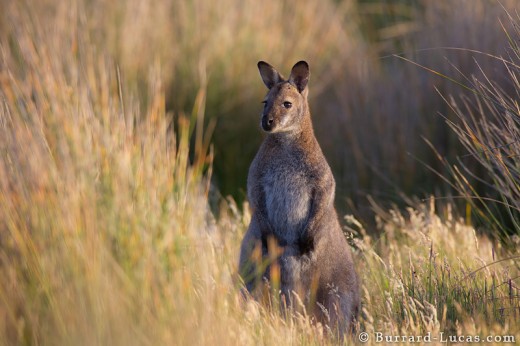 Bennetts Wallaby (Red-Necked Wallaby) (Macropus rufogriseus)
is native to Tasmania, but is not protected
(© Photo Burrard-Lucas) ^http://www.burrard-lucas.com/ Bennetts Wallaby (Red-Necked Wallaby) (Macropus rufogriseus)
is native to Tasmania, but is not protected
(© Photo Burrard-Lucas) ^http://www.burrard-lucas.com/
.
If the proposed legislation is genuinely and solely to control feral animals, the National Parks and Wildlife Service (NPWS) as delegated custodian of National Parks in New South Wales, must first answer these questions:
- Why are native animals included amongst the ferals?
- What action in fact has the NPWS undertaken over the last 20 years to control ferals in National Parks across NSW?
- Which measures have been successful at dealing with the target species and which have not?
- Which measures have caused a detrimental impact on non-target species?
- What interstate or overseas model/case study does NPWS rely upon to justify why shooting is the preferred method of control?
- What standard of identification test is imposed on would be feral shooters?
- What standard of marksmanship is required and what NPWS-approval system would be in place?
- What monitoring is to be conducted of these shooters and by whom?
- What happens to the carcasses to prevent disease?
.
If NPWS was serious about controlling feral animals in National Parks, it would have a permanent programme to specifically deal with the key threatening processes that involve ferals, namely to target:
- Competition and grazing by the feral European rabbit
- Competition and habitat degradation by feral goats
- Environmental degradation caused by feral deer
- Predation by feral cats
- Predation by the European Red Fox
- Predation, habitat degradation, competition and disease transmission by feral pigs.
SOURCE: DEC, ^http://www.threatenedspecies.environment.nsw.gov.au/tsprofile/pas_ktp.aspx
.
These feral species need to be the primary target of eradication. Professional contract shooting may be an option, but it is not for ‘weekend warrriors‘. The solution must be science-based not sport-based.
According to the Australian Wildlife Conservancy:
“Australia has the worst mammal extinction record in the world – 27 mammals have become extinct in the last 200 years. No other country or continent has such a tragic record of mammal extinctions.”
.
.
 . .
In June 2009 the Game and Feral Animal Control Amendment Bill was introduced into the NSW Upper House by Shooters Party MP Robert Brown, that would pave the way for hunting in national parks, private game reserves, the hunting of native species and the growth of recreational shooting on public and private lands (Sydney Morning Herald, page 6, 12 June 2009). Lee called on the Environment Minister Carmel Tebbutt to reject outright a new bill from the Shooters Party.
.
The NSW Government has withdrawn its support for the bill, but it is still before the NSW Parliament!
.
[Source: Australian Greens Party Senator Lee Rhiannon, ^http://archive.leerhiannon.org.au/portfolios/firearms/firearms/atct_topic_view?b_start:int=10&-C=]
.
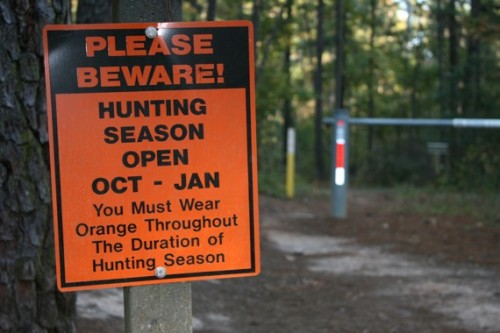
Overview of the Game and Feral Animal Control Amendment Bill 2009:
.
The object of this Bill is to amend the Game and Feral Animal Control Act 2002 (the Act) as follows:
- To enable the Minister responsible for national park estate land to make that land available for the hunting of game animals by licensed game hunters
- To expand the list of game animals that may be hunted in accordance with the Act and, in the case of any native game animals that are listed, to impose special requirements in relation to the hunting of those animals by licensed game hunters
- To provide for the operation of private game reserves under the authority of a licence granted by the (NSW) Game Council
- To make it an offence to approach persons who are lawfully hunting on declared public hunting land or to interfere with persons lawfully hunting game animals
- To make a number of other amendments of an administrative, minor or consequential nature..
.
[Source: ^ http://www.parliament.nsw.gov.au/prod/parlment/nswbills.nsf/1d4800a7a88cc2abca256e9800121f01/6dce0470707e4f4bca2575b4001bd3f1/$FILE/b2009-031-d10-House.pdf]
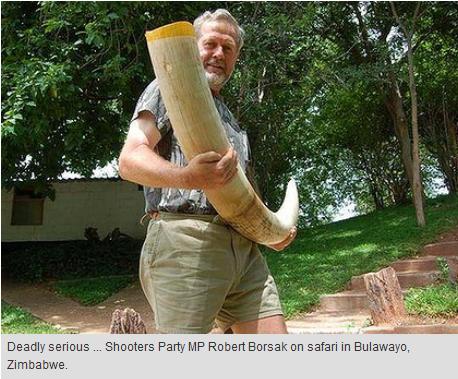
Support from the Coalition of Law Abiding Sporting Shooters Inc (CLASS):
.
‘For too long large areas of bushland has been locked away (aka protected from exploitation) as National Parks, State Forests etc. In many of those parks and forests invasive plants, such as blackberries, bracken, lantana, etc have grown unchecked, resulting in a great unbalance among local flora leading to reduced biodiversity among fauna. Permitting conservation hunting in those areas will help restore the balance, while permitting controlled harvesting of native and introduced species for food, trophies or fur/leather….the Game and Feral Animal Control Amendment Bill 2009 will go a long way to utilising the inherent value of sustainable resources which would otherwise be wasted.’
[Source: ^http://www.c-l-a-s-s.net/game-bill.htm]
 According to CLASS, wildlife in National Parks are wasted resources According to CLASS, wildlife in National Parks are wasted resources
.
.
Selected background articles at the time:

‘Government deal to open national parks to shooters’
.
[Source: Erik Jensen, 20091021, Sydney Morning Herald ^http://www.smh.com.au/environment/conservation/government-deal-to-open-national-parks-to-shooters-20091020-h6yt.html]
.
Hunters will be allowed to shoot animals in national parks for the first time under a deal offered to the Shooters’ Party by the NSW Government. The Herald understands the deal would modify a private member’s bill introduced by a member of the Shooters’ Party, Robert Brown, to allow hunting in 13 national parks if the Shooters’ Party removed demands for enclosed game reserves or safari parks from its draft legislation.
”We have had discussions with senior Labor people,” Mr Brown said. ”I’m not going to confirm or deny that we’re any closer to a resolution … My bottom line is the whole bill must be passed or we continue to withdraw our support for the Government.”
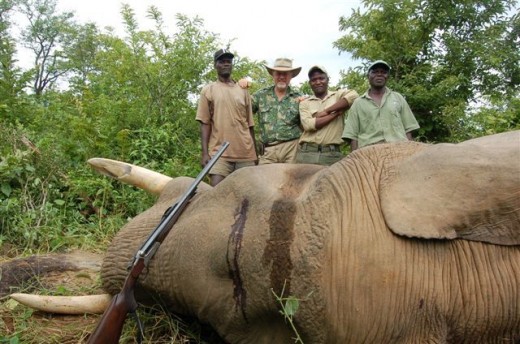
The Shooters’ Party has been holding the Government to ransom since introducing the bill in June and yesterday voted against the Government on all legislation in the upper house. Negotiations on the bill had broken down with the Premier’s chief of staff, Graeme Wedderburn – who Mr Brown described as ”tits on a bull” – but resumed in September, less than a week after John Robertson took over the environment portfolio. The Treasurer, Eric Roozendaal, one of Mr Robertson’s factional allies, took part in negotiations.
According to Mr Brown, the pair offered a memorandum of understanding that would allow hunting in national parks along the Queensland and South Australian borders. But he said the proposed parks were too far away.
”The closest one to Sydney was 10 hours’ drive,” he said. ”That [offer] was there to f— us, as far as I’m concerned.”
The Greens’ spokeswoman on animal welfare, Lee Rhiannon, said the deal was intended to allow free passage of Government legislation through the upper house but may cost Labor seats at the next election – including that of the former environment minister Carmel Tebbutt.
”We’re about to come into the busiest legislation time of the year. They’re going to have to pass 30 bills in a week,” she said. ”If they don’t have the Shooters’ on side, they’ll actually have to talk to other people. [But] as well as being ethically wrong and environmentally damaging, they will be inflicting enormous pain and damage to their own party … For Tebbutt and [Verity] Firth, they could well be putting an expiry date on their political careers.”
The acting executive officer of the National Parks Association of NSW, Bev Smiles, said her office had received an overwhelming amount of correspondence criticising the bill.
”We were hoping the Shooters were having some other face-saving deals with 12-year-olds and airguns,” Ms Smiles said, with reference to another bill the party is introducing.
”[But] with a new Minister for the Environment having an upper house position rather than an electorate, it’s all political. This particular deal has probably created more response from a broader cross-section of the community than any other issue I’ve been involved in.”
Neither Mr Robertson nor Ms Tebbutt would comment on the deal. Mr Brown said he would continue to frustrate government policy until his bill was passed in its entirety.
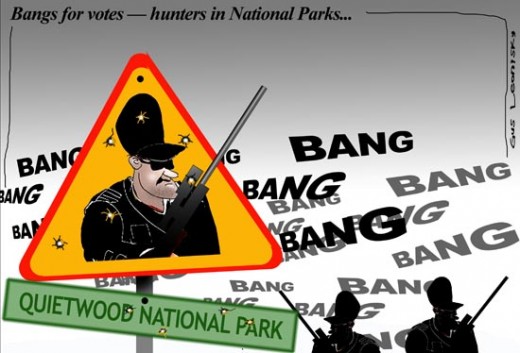
.
.
‘Greens oppose recreational hunting in national parks’
.
[Source: Marian Wilkinson, Environment Editor, Sydney Morning Herald, 20090612, ^http://www.smh.com.au/environment/conservation/greens-oppose-recreational-hunting-in-national-parks-20090611-c508.html]
.
A new bill that would open the state’s national parks and reserves to recreational hunters who could be licensed to shoot native animals and birds has been condemned by the NSW Greens, the Liberal Party and environmental groups.
The NSW Shooters Party has introduced the private members bill to Parliament. It allows for private game reserves to be set up for professional safari hunters, overturning NSW laws that prevent the enclosing of animals on land solely for hunting purposes. A Shooters Party MP, Robert Brown, said the bill would not allow the hunting of threatened species and, in the case of native waterfowl, licensed game hunters would be required to pass an official identification test of the ducks.
But the Opposition’s environment spokeswoman, Catherine Cusack, attacked the bill, saying key elements were unacceptable. “We totally reject the idea of shooting in national parks and the concept of shooting native animals in national parks is repugnant to almost anyone.”
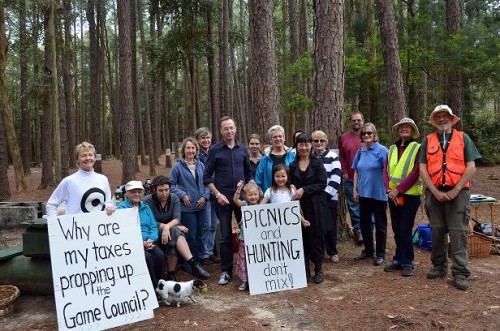
Among the birds and animals that could be hunted are the Australian wood duck, the chestnut teal and grey teal ducks, galahs, corellas and eastern grey, western grey and red kangaroos. The Shooters Party hopes to gain the Government’s support for the bill but the Environment Minister, Carmel Tebbutt, is already signalling she will oppose key provisions in it, including allowing recreational hunters into national parks and the hunting of native animals. Her spokeswoman said the Government would consider the bill’s merits but it did not support “the hunting of native animals or hunting in national parks“.
Mr Brown said the bill drew on many of the recommendations of a government-backed review of existing laws undertaken with staff from the NSW Department of Primary Industries and the Game Council.
He said that under his bill, the environment minister would be responsible for declaring any national park or reserve open to hunters. He told the Herald that opening national parks to recreational hunters to shoot feral animals would save the Government significant amounts of money and the hunting of native animals and birds in parks would require ministerial approval.
The Greens leader, Lee Rhiannon, called on Ms Tebbutt to reject the entire bill, not only the provisions concerning national parks. “Opposing shooting in national parks may well be a tactic Labor is using to divert attention from the fact it will support other equally regressive changes being pushed by the Shooters Party,” Ms Rhiannon said.
The Greens are also concerned about provisions in the bill that would make it an offence to approach anyone or interfere with anyone “lawfully hunting game animals” on any land that had been declared public hunting land.
.
.
‘Shooting in national parks dead: Macdonald’
.
[Source: AAP, 20090729, ^http://www.smh.com.au/environment/conservation/shooting-in-national-parks-dead-macdonald-20090729-e1an.html]
.
A deal with the Shooters’ Party that would allow hunting in national parks is unlikely, the NSW Government says. The Government withdrew its support for the proposal last month, prompting the Shooters to retract their support for legislation to privatise NSW Lotteries management. Primary Industries Minister Ian Macdonald said today the national parks proposal was all but dead in the water.
“The Government has been considering these issues for some time and has taken a policy position that they don’t want that type of shooting activity in national parks,” Mr Macdonald told reporters in Sydney.
“I wouldn’t say it is likely to change, but there again, there’s nothing in life that’s immutable.”

Kangaroos illegally shot through SE Forests National Park
.
.
Game and Feral Animal Control Repeal Bill 2010 – lapsed
.
On 23rd June 2010, then NSW Greens MP Lee Rhiannon introduced a private members bill to the NSW Parliament, ‘Game and Feral Animal Control Repeal Bill 2010’, designed to repeal the Game and Feral Animal Control Act 2002 and its regulations, to abolish the Game Council and to prohibit hunting for sporting or recreational purposes on national park estate land, Crown land and State forests. However although the Repeal Bill reached a second reading stage, the then Labor Premier Kristine Keneally suspended (proroged (suspended) the sitting of the NSW Parliament ahead of an election, and the Bill lapsed on 2nd September 201o.
It needs to be reinstated forthwith!
.
Overview of Bill
The objects of this Bill are as follows:
- To repeal the Game and Feral Animal Control Act 2002 and the regulations made under that Act
- To expressly abolish the Game Council and provide for the transfer of its assets, rights and liabilities to the Crown
- To prohibit hunting for sporting or recreational purposes on national park estate land, Crown land and State forests
.
‘Greens’ Bill abolishes Game Council, ends hunting in State Forests, NP‘
.
[Source: The Australian Greens, 20100624, ^http://greens.org.au/content/greens-bill-abolishes-game-council-ends-hunting-state-forests-np]
.
Greens MP Lee Rhiannon was last night given urgent leave by the NSW Upper House to introduce her private members bill to abolish the NSW Game Council and prohibit recreational hunting in national parks, state forests and public land.
The Game and Feral Animal Control Repeal Bill 2010 is now available.
“Feral animals are a significant environmental problem in Australia but the Games Council, set up as a favour by the Labor Party to the Shooters Party to shore up their vote, is a bankrupt vehicle for managing invasive species,” Ms Rhiannon said. “The more than $11 million in public funding and millions in loans spent propping up the Gaming Council since 2002 would be better spent developing an evidenced based, strategic plan using professionals to tackle invasive species.
“The Game Council was set up to be self funding, yet the Auditor General has noted its ongoing financial difficulties, with the government being forced to prop it up with loans and additional recurrent funding to manage ongoing debt problems.
“Former Premier Bob Carr’s establishment of the Game Council in 2002 was an act of unashamed capitulation to the gun and hunting lobbies, legitimising recreational animal cruelty while risking an increase in feral animal populations.
“The Greens Bill also prohibits recreational hunting in state forests, national parks and Crown Land.
“As part of the deal making between Labor and the Shooters Party, NSW’s state forests have been lately opened up to recreational shooters, risking public safety. “There is still currently a Shooters Party private members bill before parliament which if passed would broaden where recreational shooters can hunt to include national parks.
“The NSW government has agreed to various demands by the Shooters Party for changes to gun ownership laws in recent years and there is no guarantee that shooting in national parks will not be next on the list. “In the interests of the environment and good government NSW Labor should support the Greens’ bill to abolish the Game Council and ensure the professional and scientific management of invasive species in NSW,” Ms Rhiannon said.
.
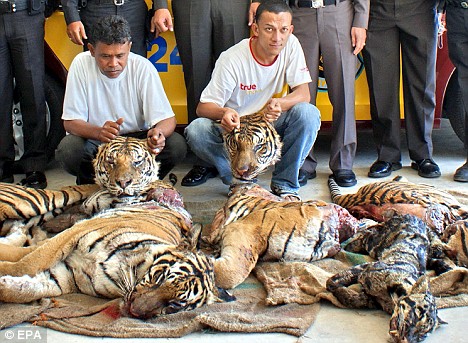
It’s 2011 and we’re still killing Tigers!
[‘Police Seize Firearms Used by Wildlife Officials to Fight Off Poachers‘ by Sarah Pappin, Bushwarriors, 20100716,
^http://bushwarriors.wordpress.com/tag/south-china-tiger/]
.
In only the last eight years, the Bengal Tiger population has decreased by over 61% and is now frighteningly close to extinction with only 1,400 of the cats left. Habitat loss and poaching are to blame for their decline. Nagarhole Tiger Reserve is home to the highest density of these tigers in all of India, attracting a heavy and constant flow of poachers. Forest officers tasked with protecting the National Park’s tiger population (and other wildlife) from the poachers are now impeded by a devastating combination of muddy monsoon conditions and a complete lack of defense.
Comments:
.
Arvind Telkar (20100717): “Poaching is one of the heinous crimes, which must be dealt with a very severe punishment. The law should be changed in such a manner, that he must think hundred times before aiming any wild animal.”
.
Franklin Joel (20100717): “Thank you very much for sharing,I am sharing this on my wall. Please do something to Stop Poaching, My eyes are wet seeing these pictures..The Hon. court should pronounce the highest punishment to these people….”
.
Anne Maher (20100719): “Absolute tragedy. Decisions made by idiots. They must be in on the corrupt poaching activities to leave the Wildlife rangers and the Tigers so unprotected. Spare us from brainless individuals.”
.
Amay (20100903): “What cruel people they are the biggest criminals i hav ever seen in my life how badly these people hav cut the tigers they truly deserve a capital punishment.”
.
Zachary (20101118): “What the hell is wrong with these people?! why don’t they do something to stop this? I don’t give a damn if they think that certain parts have special healing or good luck charms, this is wrong! This is just digusting.”
.
 An effective tool against poachers An effective tool against poachers
.
 An effective but under-resourced force against poachers An effective but under-resourced force against poachers
.
Tags: animal cruelty, Australian Wood Duck, Bennetts Wallaby, Coalition of Law Abiding Sporting Shooters, Game and Feral Animal Control Amendment Bill 2009, Game and Feral Animal Control Repeal Bill 2010, hunting, hunting season, illegal shooting, Lee Rhiannon, national parks, NSW Game Council, NSW Government, Premier Nathan Rees, SE Forests National Park, Shooters and Fishers Party, still killing Tigers, weekend warriors, Wildlife, wildlife poaching
Posted in Africa, Birds (Australian), Birds (Migratory), Blue Mountains (AU), Elephants, Kangaroos and Macropods, Threats from Poaching and Poisoning | No Comments »
Add this post to Del.icio.us - Digg
Leave a Reply
You must be logged in to post a comment.
December 2nd, 2011
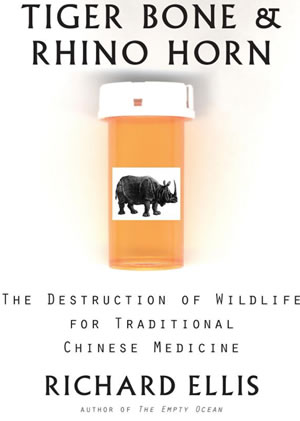
Mass murder is considered possibly the worst crime that can be committed.
But there is a worse crime than mass murder and worse than war crime, and worse than crimes against humanity. Murder; extermination; torture; rape; political, racial, or religious persecution and other inhumane acts reach the threshold of crimes against humanity only if they are part of a widespread or systematic practice.
Even worse than crimes against humanity is the extreme extension of mass murder – genocide. Genocide is “the deliberate and systematic destruction, in whole or in part, of an ethnic, racial, religious, or national group”. What crime could possible be more evil than the willful targeting of an entire part of the human species in order to systematically wipe it out of existence? – such as what has been attempted upon the Jews, Armenians, Rwandan Tutsis, Bosnian Muslims, Sri Lankan Tamils.
 Armenian Genocide 1915 Armenian Genocide 1915
.
“More inhumanity has been done by man himself than any other of nature’s causes.”
~ (1673) by Samuel von Pufendorf
.
Yet still, there is a worse crime. It is the deliberate and systematic destruction, in whole or in part, of an entire species from the planet. In the same vein as genocide, is human-caused extinction or ‘speciescide‘, a relatively new concept. It is new concept because humans have only recently recognised species extinction as a problem. It is also a new concept because the global rate of non-human species extinction is increasing at an accelerating rate.
‘Speciescide‘ is a derived concept from the ecophilosophy of ‘speciesism‘ being a prejudice manifested as a widespread discrimination practised by humans against other species (Richard D. Ryder, 1973).
Yet deliberately causing a species to become regionally extinct, extinct in the wild or globally extinct, are not yet recognised as crimes legally. Human-caused extinction of a species is not yet a criminal offense.
Yet it is the most immoral crime that can be inflicted on the planet. Even if a nuclear holocaust wiped out 6 billion of the human species, there would still be one billion surviving from which to perpetuate the species. But wiping out an entire species is absolute, irreversible, extincting.
The Convention on the Prevention and Punishment of the Crime of Genocide establishes “genocide” as an international crime, which signatory nations “undertake to prevent and punish.”
It says that genocide means any of the following acts committed with intent to destroy, in whole or in part, a national, ethnical, racial or religious group, as such:
- Killing members of the group;
- Causing serious bodily or mental harm to members of the group;
- Deliberately inflicting on the group conditions of life calculated to bring about its physical destruction in whole or in part;
- Imposing measures intended to prevent births within the group;
- Forcibly transferring children of the group to another group.
.
Speciescide is a worse crime than described by the above definition of genocide and even worse than the previous “the deliberate and systematic destruction..” definition.
Speciescide is ecological genocide. It entails annihilating very member of a species until there is no surviving individual on the planet – the entire species becomes globally extinct. They will never be seen again on the planet. Speciescide is thus the worst hate crime possible. Speciescide is what Tasmanian colonists did to the Thylacene. It is what Traditional Chinese Medicine has just committed upon Africa’s Western Black Rhinoceros.
.
.

‘Africa’s Western black rhino declared extinct’
[Source: ‘Africa’s Western black rhino declared extinct’, Los Angeles Times, 20111010, ^http://latimesblogs.latimes.com/world_now/2011/11/africa-western-black-rhino-extinct-conservation.html]
.
Africa’s Western black rhino has officially been declared extinct and other subspecies of rhinoceros could follow, according to the latest review by a leading conservation organization.
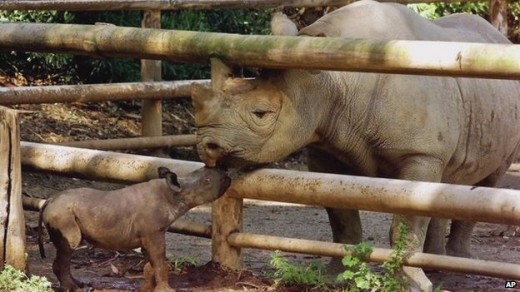 Western Black Rhino and her calf – never again on the planet Western Black Rhino and her calf – never again on the planet
.
The International Union for Conservation of Nature listed the Northern white rhino in central Africa as “possibly extinct in the wild” and the Javan rhino as “probably extinct” in Vietnam.
The organization blamed a lack of political support for conservation efforts in many rhino habitats, international organized crime groups targeting the animal, increasing illegal demand for rhino horns and commercial poaching.
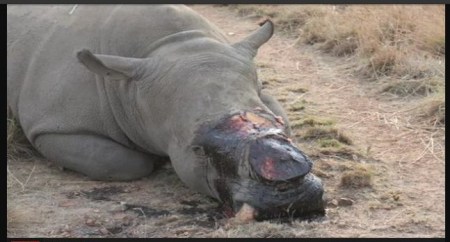
“In the case of both the Western black rhino and the Northern white rhino, the situation could have had very different results if the suggested conservation measures had been implemented,” Simon Stuart, chairman of IUCN’s Species
Survival Commission, said in a statement Thursday. “These measures must be strengthened now, specifically managing habitats in order to improve breeding performance, preventing other rhinos from fading into extinction.”
The last Javan rhino in Vietnam is believed to have been killed by poachers in 2010, reducing the species to a tiny, declining population in Java.
.
The rhinos were among more than 61,900 animal and plant species reviewed for the IUCN’s latest Red List of Threatened Species. A quarter of the mammals on the Red List were found to be at risk of extinction. But the organization said there
have also been conservation successes. Fewer than 100 Southern white rhinos survived at the end of the 19th century, but the population in the wild is now believed to number over 20,000. Numerous other species are threatened, including many types of plants. The Chinese water fir, which used to be widespread throughout China and Vietnam, was listed as “critically endangered,” due primarily to expanding intensive agriculture. The IUCN also listed five out of eight tuna species as “threatened” or “near threatened,” and added 26 recently discovered amphibians to the Red List, including the blessed poison frog.
“This update offers both good and bad news on the status of many species around the world,” said Jane Smart, director of the IUCN Global Species Program. “We have the knowledge that conservation works if executed in a timely manner, yet, without strong political will in combination with targeted efforts and resources, the wonders of nature and the services it provides can be lost forever.”
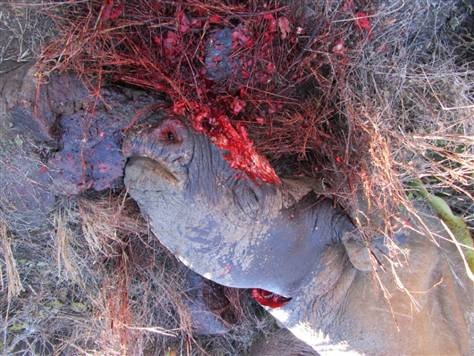 Stumpy’s lifeless body, her life stolen by poachers
(Photo credit: Lewa Wildlife Conservancy)
. Stumpy’s lifeless body, her life stolen by poachers
(Photo credit: Lewa Wildlife Conservancy)
.
‘Stumpy was the oldest female black rhino at the Conservancy, and had spent 26 years enjoying her freedom on the property. Her eighth calf, only a year and a half old, was dealt a minor wound to the neck in the incident and will survive. Coincidentally, on the day Stumpy drew her last breath, a first breath was taken by a newborn rhino at the rhino refuge.’
.
[Source: ^http://bushwarriors.wordpress.com/tag/rhino-horn-trade/page/6/]
.
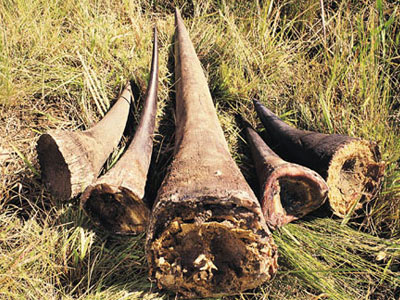
.
.
‘DEAD MEN DON’T DEAL’ Campaign
.
Rhinos have been slaughtered to near extinction to satisfy the demand of rhino horn products in China and Vietnam. All based on rhino horn cultural myths. It has the same effect as chewing ones fingernails.
China is costing the world its rhinos.
.
- It is seen as a remedy for nearly everything (evil possession included) in China and Vietnam
- China and Vietnam fund international organized poaching teams to kill rhino.
- Science proves there is no medicinal value about rhino horn.
- Rhino is said to be the most endangered species to date.
.
However, even if Chinese trade makers are aware that the Rhino population is on near brink to extinction; the continual demand for rhino horn persists.
Unless a serious measure evolves, Chinese businessmen will not stop.
(Ed: This is speciescide)

So, the idea sprung to mind to form a campaign that will create a cultural scare. Namely, the DEAD MEN DON’T DEAL campaign that revolves around the sudden deaths of dealers. Without knowing who or how these smugglers are tortured it will create a cultural scare amoungst those who are guilty. The idea derives from laying revenge out into the air. The revenge of the rhino. Getting back at those who took away a lot of the rhino population. The main objective here is to create fear for those who are involved in the illegal dealing of rhino horn.
.
Dehorning
The demand for Rhino has become so high that conservation officials have gotten to the point where they actually saw off their horns so rhino poachers will have no cause to kill them. These desperate measures have raised questions if removing Rhino horn impairs the rhino’s ability to survive or reproduce; one usage of the horn is to defend a mother’s young from predators.
Many parks and game reserved have battled the on going poaching around this endangered specie. Dr David Mabunda- Chief executive of SANParks stated that it is no longer appropriate to refer to this illegal action as poaching anymore as the levels of sophistication, violence and money behind it continue to raise. He also stated that the country has been working hard to bring this nearly extinct specie back, even if it requires one to become the last standing man.
Endangered stats continue to rise as reports keep coming in. In January an epidemic occurred where poachers were found using aircraft to hunt down rhino in Harare-Zimbabwe, as demand in Asia was great due to medicinal benefit growth. 7 endangered rhinos were killed, this representing one third of 22 rhinos poached throughout 2010. South Africa has about 1000 surviving rhino’s n which extra help for their existence has been sent, last year 333 rhinos were poached in South Africa nearly three times as many then 2009. However, 2011 proves to have lowered the killings. South Africa has over 21 000 more rhinos then any country in the world which puts the country as well as the animals in greater danger.
Demands in Vietnam have been noticed to increase. The black market offers huge amounts of money for trading these species for Traditional Chinese Medicine such as high blood pressure and other impairments. Experts state that as little as 5 rhinos remain in Vietnam. South Africa has become internationally known for banning rhino horn distribution.
World efforts to ‘demystify’ the medicinal affects of rhino horn fail to reach Asia and thus the uproar continues.
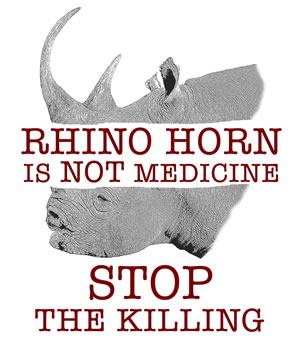
[Source: ^ http://savetherhino.wordpress.com/]
.
.
“For one species to mourn the death of another is a new thing under the sun. The Cro-Magnon who slew the last mammoth thought only of steaks. The sportsman who shot the last passenger pigeon thought only of his prowess. The sailor who clubbed the last auck thought of nothing at all. But we, who have lost our pigeons, mourn the loss. Had the funeral been ours, the pigeons would hardly have mourned us. In this fact, rather than in Mr. DuPont’s nylons or Mr. Vannevar Bush’s bombs, lies objective evidence of our superiority over the beasts.”
.
~ Aldo Leopold: ‘A Sand County Almanac, and Sketches Here and There‘, 1948, Oxford University Press, New York, 1987, pp. 109-110.
.
.
.
Further Reading:
.
[1] Book: ‘ Tiger Bone and Rhino Horn: The Destruction of Wildlife for Traditional Chinese Medicine‘
by Richard Ellis
Format: Hardcover, 294 pages, Revised and Tea Edition
Release Date: 27 May 2005
‘In parts of Korea and China, moon bears, black but for the crescent-shaped patch of white on their chests, are captured in the wild and imprisoned in squeeze cages, where steel catheters drain their bile as a cure for ailments ranging from upset stomach to skin burns. Rhinos are being illegally poached for their horns, as are tigers for their bones, thought to improve virility. Booming economies and growing wealth in parts of Asia are increasing demand for these precious medicinals while already endangered species are being sacrificed for temporary treatments for nausea and erectile dysfunction. Richard Ellis, one of the world’s foremost experts in wildlife extinction, brings his alarm to the pages of “Tiger Bone & Rhino Horn”, in the hope that through an exposure of this drug trade, something can be done to save the animals most direly threatened. Trade in animal parts for traditional Chinese medicine is a leading cause of species endangerment in Asia, and poaching is increasing at an alarming rate. Although most of traditional Chinese medicine is not a cause for concern because it relies on herbs and other plants, as wildlife habitats are shrinking for the hunted large species, the situation is becoming ever more critical. Ellis tells us what has been done successfully, and contemplates what can and must be done to save these rare animals from extinction.’.
[Source: ^http://www.fishpond.com.au/Books/Tiger-Bone-and-Rhino-Horn-Richard-Ellis/9781559635325]
.
.
.
Tags: China, ecological genocide, ecophilosophy, extincting, Richard Ellis, speciescide, speciesism, TCM, TCM witchdoctor cult, tiger bone and rhino horn, Traditional Chinese Medicine, Vietnam, Western Black Rhino extinct, wildlife poaching
Posted in 21 Going Khaki!, Rhinoceroses, Threats from Poaching and Poisoning, Tigers | No Comments »
Add this post to Del.icio.us - Digg
Leave a Reply
You must be logged in to post a comment.
December 1st, 2011
Corporate Tin Miner:
“We will continue to be aggressive explorers with multiple rigs focused on exploration for the foreseeable future.”
.
~ Venture Minerals (corporate tin miner from Perth), in its Mt Lindsay-Investor Presentation,
(Nov 2011), p.31
.
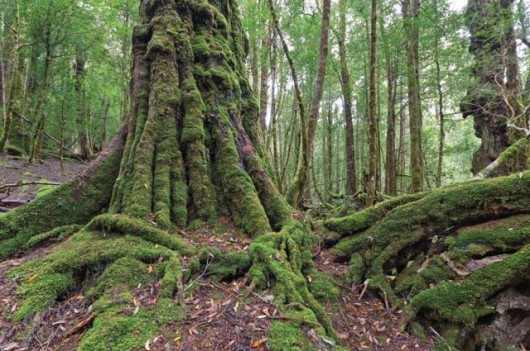 ‘The Tarkine’ – 430,000 hectares of ancient Tasmanian forest ‘The Tarkine’ – 430,000 hectares of ancient Tasmanian forest
Tasmania’s ancient Myrtle/Sassafras forest – threatened by loggers, logger ‘adventure tourism’, roads and now bloody tin mining!
[Photo by Peter Walton, Tasmanian Expeditions – Photo Gallery on The Tarkine, ^http://www.tasmanianexpeditions.com.au/index.php?section=photo_highlights&id=285742]
.
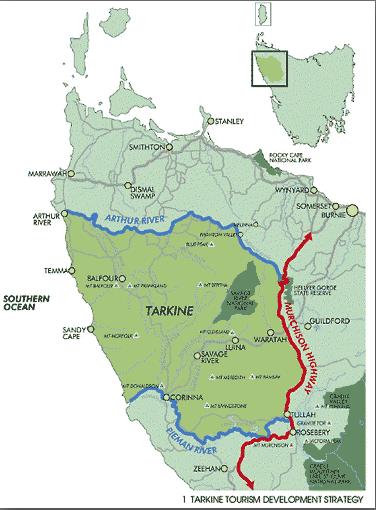 Cradle Coast Authority (CCA), North West Tasmania’s map
as part of a tourism development strategy. Cradle Coast Authority (CCA), North West Tasmania’s map
as part of a tourism development strategy.
.
A bid to restore emergency National Heritage protection to the Tarkine wilderness in Tasmania’s north-west has been launched by environmentalists to head off a ”Pilbara-style” mine in the rainforest. Several conservation groups lodged the nomination with the Environment Minister, Tony Burke, hoping he will count heritage values in his impending decision on the big Venture Minerals’ Mount Lindsay open cut project.
Emergency listings of The Tarkine have been granted four times since 2004!
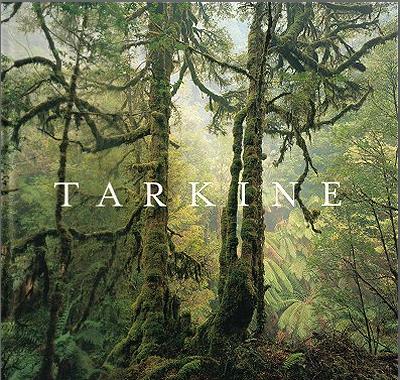 Moss-clad Sassafras (Atherosperma moschatum) trees in the Arthur River catchment near Waratah, Tarkine, Tasmania
(Photo © Ted Mead November 2003)
[Front Cover of the 2004 book, ‘Tarkine‘ edited by Ralph Ashton, and available from publishers Allen and Unwin,and just purchased by The Habitat Advocate.
Available at: ^http://www.allenandunwin.com/default.aspx?page=94&book=9781742372846]
Moss-clad Sassafras (Atherosperma moschatum) trees in the Arthur River catchment near Waratah, Tarkine, Tasmania
(Photo © Ted Mead November 2003)
[Front Cover of the 2004 book, ‘Tarkine‘ edited by Ralph Ashton, and available from publishers Allen and Unwin,and just purchased by The Habitat Advocate.
Available at: ^http://www.allenandunwin.com/default.aspx?page=94&book=9781742372846]
.
…but that’s not how the ‘Tin Men‘ see The Tarkine…
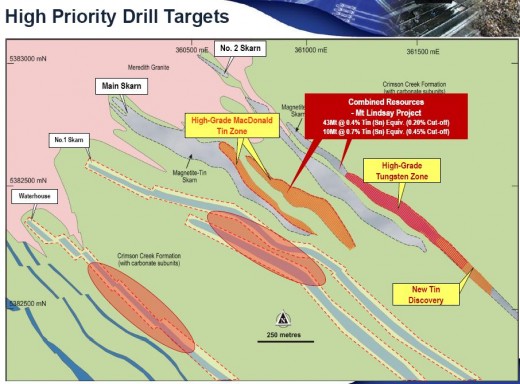 This is how the ‘Tin Men‘ see the Tarkine… for its tin and tungsten.
(Source: Venture Minerals’ Mt Lindsay-Investor Presentation, Nov 2011) This is how the ‘Tin Men‘ see the Tarkine… for its tin and tungsten.
(Source: Venture Minerals’ Mt Lindsay-Investor Presentation, Nov 2011)
.
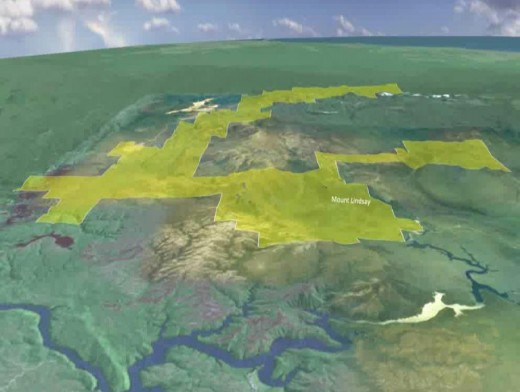 …and this is how the ‘Tin Men’ see the Tarkine… for the vast mining lease area they are happy to exploit and lay to waste. …and this is how the ‘Tin Men’ see the Tarkine… for the vast mining lease area they are happy to exploit and lay to waste.
(Source: Venture Minerals’ Mt Lindsay-Investor Presentation, Nov 2011)
.
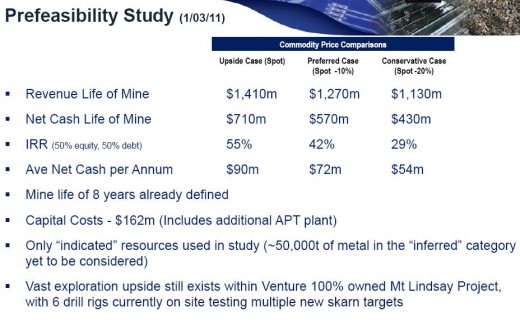 …and this is how the Tin Men see the Tarkine – for its ‘Super Mining Profits’ … 30 to 55% return! …and this is how the Tin Men see the Tarkine – for its ‘Super Mining Profits’ … 30 to 55% return!
(Source: Venture Minerals’ Mt Lindsay-Investor Presentation, Nov 2011)
.
The Mount Lindsay tin project is the largest of several mines planned around the Tarkine in an emerging new Tasmanian environmental battle. The Tarkine National Coalition said up to nine new open cut mines are in development there. Mr Burke allowed a previous emergency listing for the Tarkine to lapse a year ago when he said plans for a road through the wilderness were dropped. Environment groups objected because of what they said were increasing threats from mining.
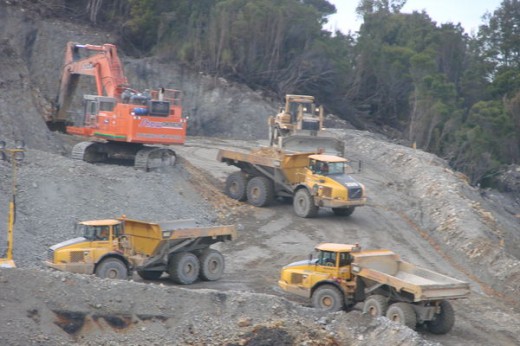 Corporate Miner ‘Metals X’ getting well stuck into a Tarkine rainforest hillside at nearby Mount Bischoff Corporate Miner ‘Metals X’ getting well stuck into a Tarkine rainforest hillside at nearby Mount Bischoff
.
The 430,000-hectare Tarkine region is undergoing a protracted assessment for future listing by the Australian Heritage Council. But because the wilderness now lacks any listing, Mr Burke is unable to consider heritage values in an approval of the Mount Lindsay mine under the Environment Protection and Biodiversity Conservation Act. Instead, his decision is likely to focus on protection of endangered species such as the Tasmanian Devil. The Tarkine is the wildest remaining stronghold for healthy devils, stricken across the rest of the island by a deadly facial cancer.
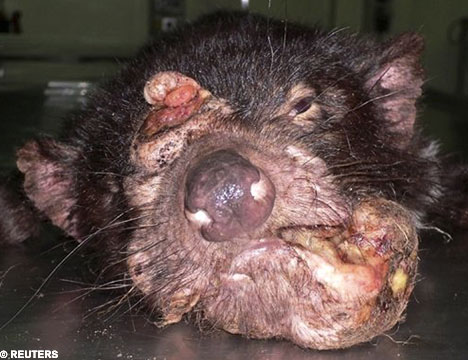 The Tarkine is a refuge for healthy Tasmanian Devils to avoid the genocidal tumour disease
..but what could heartless commercial ‘Tin Men’ care?
Think of the ‘Super Mining Profits’ … 30 to 55% return! The Tarkine is a refuge for healthy Tasmanian Devils to avoid the genocidal tumour disease
..but what could heartless commercial ‘Tin Men’ care?
Think of the ‘Super Mining Profits’ … 30 to 55% return!
.
The Tarkine National Coalition spokesman Scott Jordan said yesterday:
”Companies, including Venture, are using the removal of the heritage protections to ramp up exploration activities including roading and drilling that are having a significant effect on the values of the area.”
.
The coalition was joined by the World Wildlife Fund, the Australian Conservation Foundation and The Wilderness Society in seeking the listing. An Australian National University environmental law specialist, Andrew Macintosh, said emergency listings had been granted four times since 2004, but Mr Burke was not compelled to respond to the request. In a statement, Mr Burke did not respond directly to the emergency listing request, but said he would continue meeting with different groups on issues surrounding the heritage listing of the Tarkine. [Editor’s note: in fact there has been one emergency National Heritage listing (Dec 2009 – Dec 2010), one National Heritage nomination (2004), three emergency National Heritage nominations (Nov 2009, Mar 2011 and Nov 2011), and two AHC recommendations (2003 and Sep 2010)… so what’s it bloody take to get the message through?]
.
[Source: ‘ Call for heritage listing of the Tarkine to head off tin mine‘, Sydney Morning Herald, 20111119, ^ http://www.smh.com.au/national/call-for-heritage-listing-of-the-tarkine-to-
head-off-tin-mine-20111118-1nndq.html]
.
.
‘Jobs, jobs, jobs’ justification – but all for mainlanders, foreigners and short-termers
.
Typically, this miner (Venture Minerals) relies on the standard jobs justification to exploit, dig up, pollute and destroy the Tarkine Wilderness for tin. Venture Mineral is promising 700 jobs! But of those , 500 jobs involve construction – so short term fly ins from the mainland and overseas only during construction phase. The remaining 200 jobs are promised for the mine’s operations. But miners don’t train locals. This is not about Tasmanian jobs. These 200 jobs will be sourced from similar mines on the mainland and indeed from overseas all on on Federal Labor’s 457 Visa (Australian worker displacement) Scheme. Just look at OZ Minerals at Rosebery.
457 Visas: ‘..for employers who would like to employ overseas workers to fill nominated skilled positions in Australia, to employ overseas workers for a period of between one day and four years.’
[Source: ^http://www.immi.gov.au/skilled/skilled-workers/sbs/]
.
Venture Minerals is Perth-based at 181 Roberts Road Subiaco, another West Australian corporate miner exploiting Tasmania and taking the profits offshore. Venture Minerals forecasts $1 billion in revenue but it won’t go to Tasmanians. It will go back to West Australia and to its rich mine shareholders. Typically mining is eco-rape, pillage and plunder – wam, bam, thank you mam, then pissing off back to where one came, leaving another tin moonscape like Mount Bischoff.
Look at the mining legacies across Tasmania left as moonscapes:
 Nearby Mount Bischoff Tin Mine – wam, bam, thank you mam! Nearby Mount Bischoff Tin Mine – wam, bam, thank you mam!
.
- Kara Mine in Hampshire
- Mount Lyle’s sulphuric moonscape
- Henty Mine
- Briseis Mine at Derby
- Pioneer Mine on Bradshaws Creek
- Anchor Mine on Blue Tier
- Gladstone Mine
- Coles Bay Mine
- Ben Lomond Mine
- St Paul’s River Mine
- Flinders Island Mines
- Mount Heemskirk
- Mount Balfour
- Renison Bell
- Stanley River
- Mount Cleveland
- Cox Bight
- Melaleuca
- etc
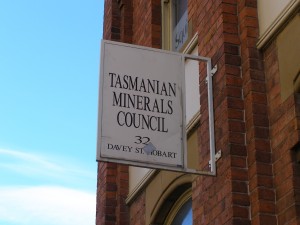
And of course the Tasmanian Minerals Council backs mining in The Tarkine. And of course it opposes national heritage listing of the Tarkine. The Tasmanian Minerals Council is only about the financial bottom line, exploitation of ore and perpetuating its own existence.
 The Tasmanian Minerals Council claims that there are “already enough layers of protection across the Tarkine region, where about 80% of the land has been put in multiple use reserves that allow mining“. The Tasmanian Minerals Council claims that there are “already enough layers of protection across the Tarkine region, where about 80% of the land has been put in multiple use reserves that allow mining“.
What ‘layers of protection’? If 80% of the Tarkine is reserved form mining, how can that be for protection? – for protection of mining profits and royalties perhaps.
So Tony Burke, if you’re not to pre-occupied with resolving the future of the Murray-Darling, what time are you allocating for Tasmania’s ancient Myrtle forests?
.
.
.
‘Tasmania’s Tarkine wilderness is one of the world’s largest temperate rainforests.
This vast expanse is a wilderness wonderland of wild rivers, dramatic coastal heathlands, button grass plains, bare mountains, ancient Huon pines, giant eucalypts and myrtles and extraordinary horizontal scrub.
It is home to rare and endangered birds – like the Orange-bellied parrot and the White goshawk – and countless animals such as the Eastern pygmy possum. This superbly illustrated book captures the beauty of this unique wilderness.’
.
[Source: ^http://www.andrewisles.com/all-stock/publication/tarkine]
.
Orange-bellied Parrot
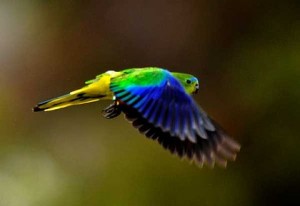 ‘Here at Melaleuca, six days’ walk from the nearest road,
such moments of peace are typically broken by bird calls,
including the distinct buzzing of the orange-bellied parrot’.
.
[Source: ‘Scientists Race To Rebuild Parrot Population’, by Peter Ker, Sydney Morning Herald, 20110207, ^http://www.globalanimal.org/2011/02/07/scientists-race-to-rebuild-parrot-population/29032/] ‘Here at Melaleuca, six days’ walk from the nearest road,
such moments of peace are typically broken by bird calls,
including the distinct buzzing of the orange-bellied parrot’.
.
[Source: ‘Scientists Race To Rebuild Parrot Population’, by Peter Ker, Sydney Morning Herald, 20110207, ^http://www.globalanimal.org/2011/02/07/scientists-race-to-rebuild-parrot-population/29032/]
.
Current status:
‘The Orange-bellied parrot (Neophema chrysogaster) is one of 18 birds listed as endangered under the Tasmanian Threatened Species Protection Act 1995. It is also listed as endangered under the Federal Act and has the dubious honour of being one of the most endangered birds Australia wide.
Why is it endangered? The Orange-bellied parrot is endangered because it is so rare (only 200 birds left) and its habitat is quickly disappearing.
.
There are only about 50 breeding pairs of this bird left!
..but what could heartless commercial ‘Tin Men’ care?
Think of the ‘Super Mining Profits’ … 30 to 55% return!
.
‘…It is a breeding endemic of Tasmania, which means that it only breeds in Tasmania. In fact it only breeds in one place in Tasmania and that is in our Southwest National Park. It arrives here in summer, nesting in eucalypt tree hollows adjacent to the parrot’s feeding grounds of extensive coastal buttongrass plains.’
.
[Source: http://www.dpiw.tas.gov.au/inter.nsf/webpages/bhan-54g3c5?open]
.
Tags: 457 visas, Cradle Coast Authority, Environment Minister, high priority drill targets, Melaleuca, Metals X, Mount Lindsay, Orange-bellied Parrot, Pieman River, super mining profits, Tarkine Tourism Development Strategy, Tarkine Trails, Tarkine wilderness, Tasmania, Tasmanian Devil, Tasmanian Minerals Council, The Tarkine, tin man, tin men, tin mine, Tony Burke, tungsten mine, Venture Minerals, wam bam thank you mam
Posted in Birds (Australian), Tasmania (AU), Tasmanian Devils, Threats from Mining, Threats to Wild Tasmania | 8 Comments »
Add this post to Del.icio.us - Digg
Leave a Reply
You must be logged in to post a comment.
|
|
 Pinnacle of Mount Wellington, Tasmania
(Photo by Editor 20111001, free in public domain, click photo to enlarge)
Pinnacle of Mount Wellington, Tasmania
(Photo by Editor 20111001, free in public domain, click photo to enlarge)
 Absolute environmental destruction above Queenstown, Tasmania
Absolute environmental destruction above Queenstown, Tasmania An Australian native tree discriminated against by a pro-development Court ruling…because it may be dangerous
^http://www.savethetree.org/
An Australian native tree discriminated against by a pro-development Court ruling…because it may be dangerous
^http://www.savethetree.org/
 Sir Patrick Geddes (c.1886)
Sir Patrick Geddes (c.1886)
 An example of current housing encroachment into bushland
Faulconbridge, Blue Mountains, New South Wales, Australia
An example of current housing encroachment into bushland
Faulconbridge, Blue Mountains, New South Wales, Australia Faulconbridge juxtapositioned to the Blue Mountains World Heritage Area.
[Source: Google Maps]
Faulconbridge juxtapositioned to the Blue Mountains World Heritage Area.
[Source: Google Maps]
 A mature native tree in a forest but on death row
so that property developers can build a house or two.
(St Georges Terrace, Faulconbridge, Blue Mountains, New South Wales Australia,
Source: ^http://savethetree.org)
.
A mature native tree in a forest but on death row
so that property developers can build a house or two.
(St Georges Terrace, Faulconbridge, Blue Mountains, New South Wales Australia,
Source: ^http://savethetree.org)
.
 ‘How has the concept of wild nature changed over the millennia? And what have been the environmental consequences? In this broad-ranging book Max Oelschlaeger argues that the idea of wilderness has reflected the evolving character of human existence from Paleolithic times to the present day. An intellectual history, it draws together evidence from philosophy, anthropology, theology, literature, ecology, cultural geography, and archaeology to provide a new scientifically and philosophically informed understanding of humankind’s relationship to nature.
‘How has the concept of wild nature changed over the millennia? And what have been the environmental consequences? In this broad-ranging book Max Oelschlaeger argues that the idea of wilderness has reflected the evolving character of human existence from Paleolithic times to the present day. An intellectual history, it draws together evidence from philosophy, anthropology, theology, literature, ecology, cultural geography, and archaeology to provide a new scientifically and philosophically informed understanding of humankind’s relationship to nature.





































































how much more of the planet do we really need to mine?this planet is mine too!
Bit over the top aren’t you?
Are Venture Minerals (the main company you seem to be attacking) trying to mine the entire 430,000 hectares? I suspect the operation would have a very small footprint and 99% of the area would be unaffected. It’s not just the 200 primary long-term workers who benefit – local businesses will see plenty of money spent with them to the profit of many local Tasmanians
Campbell,
What right does aggressive exploitation have in a ecologically precious and rare wilderness that is one of the few surviving homes to Tasmanian threatened species?
The jobs argument is as selfish as the profit argument. The jobs are short term, and most will be outsourced to non-Tasmanians. The profit goes back to Perth and overseas financiers.
…Leaving Tasmania’s natural wilderness asset destroyed. Wam bam thank you mam!
Bit 19th Century isn’t it?
“…Leaving Tasmania’s natural wilderness asset destroyed. Wam bam thank you mam!”
Yes – if they were mining the entire 430,000 hectares I would agree, but they’re not. Like I pointed out the mine footprint would be very small, thus only affecting a very small part of the Tarkine, leaving the rest of it as it was, threatened species unaffected. For this small price we get local employment, cash injection to local business, economic stimulus – all things the local economy desperatly needs you’d agree? I know a few people from Tullah that do!
The roads that have been developed through the area in the past have hardly destroyed the Tarkine – why would these small mines? They probably have a similar impact footprint.
Blanket bans over vast tracts of land is not the answer.
Tasmania has been more than 75% denuded of native forests. Pick on the denuded areas instead of raping the last virgin islands of pristine wilderness.
Tasmania’s mining legacy is Mt Lyell, Queenstown, Zeehan, Beaconsfield, Hellyer, Henty, Rosebery, Renison, Savage River and Avebury. Go taste the tailings!
Mining in Tasmania is selfishly destructive and offers no job security to Tasmanians, pillaging Tasmania for private wealth in Perth and overseas financiers.
Mineral Resources Tasmania and mining have no legitimacy in Tasmania.
Mining has the same 19th Century backward loser image of Kim Jong Un.
Wow that’s quite a vitriolic spiel. Dialogue like that only entrenches the general public’s views of causes like yours are being run by rabid militant greenies who wish to keep the country and its people in the Stone Age.
Drive a car do you? Own a computer? Have electricity in your home? All come from this mining you seem to so bitterly despise. Hypocrisy you think?
If you want to get the public on your side you need to tone down the rhetoric at touch I think, develop a more reasonable position on economic development and be willing to sit down with other groups and help develop a workable solution for all.
Campbell, publicise an Environmental Impact Statement on your proposed mine and provide a link to it, then we may continue on a level playing field.
Tearing a gaping series of holes in an remnant 50 million year old forest and so many jobs. Money for eight years is so shortsighted that it defies intelligence to even propose it, but dumping toxic tailings under strict enviromental conditions and the damage that has done worldwide may have lead to a blinkered approach to long term global devolution.